Supply Chain Management at Skyworks Solution
VerifiedAdded on 2022/11/19
|23
|5476
|237
AI Summary
This report discusses the issues within supply chain management at Skyworks Solutions and proposes appropriate models for enhancing the supply chain of Skyworks Solution Company. The report includes a brief literature review for supply chain management strategies and a critical evaluation of the proposed strategy.
Contribute Materials
Your contribution can guide someone’s learning journey. Share your
documents today.
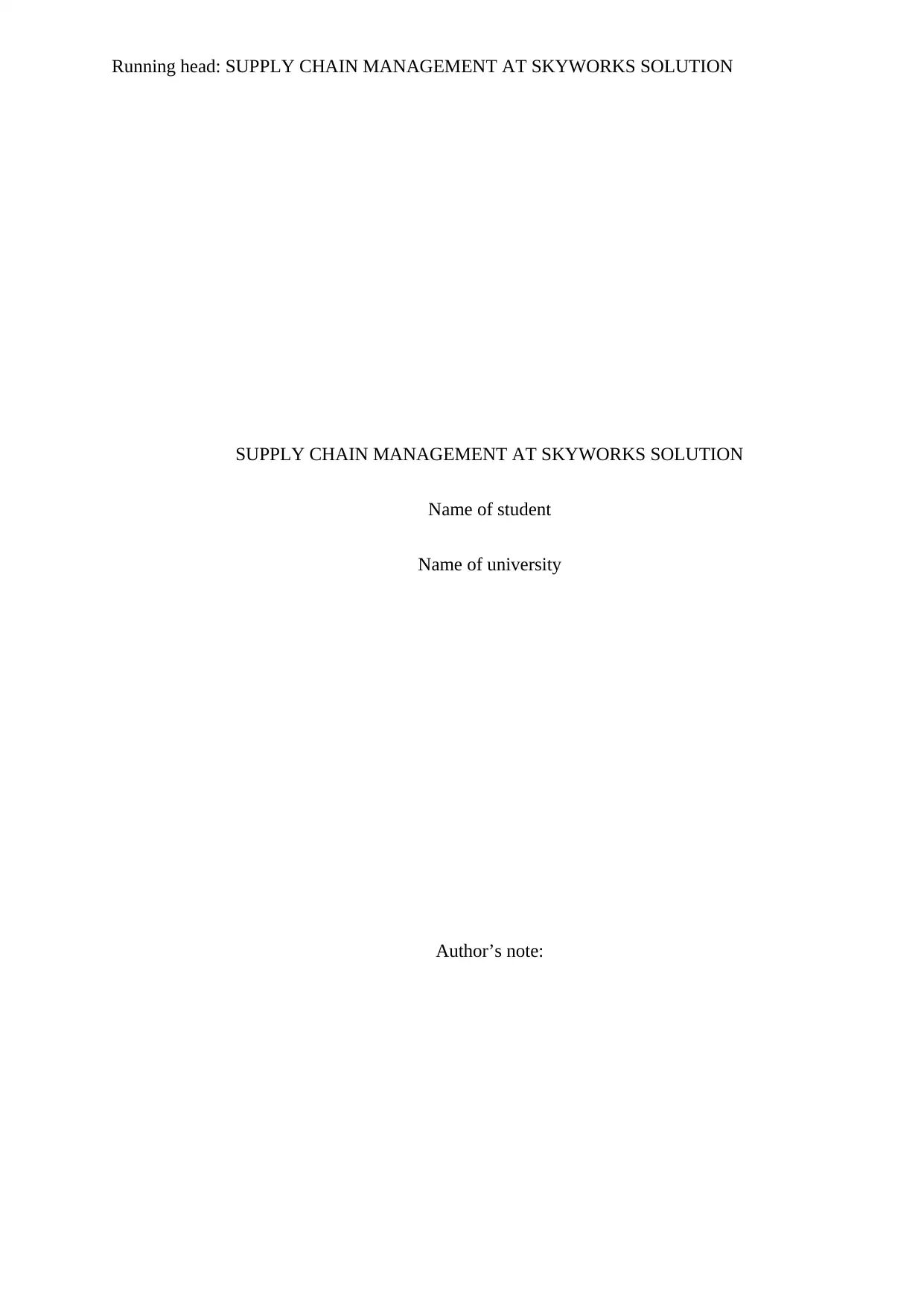
Running head: SUPPLY CHAIN MANAGEMENT AT SKYWORKS SOLUTION
SUPPLY CHAIN MANAGEMENT AT SKYWORKS SOLUTION
Name of student
Name of university
Author’s note:
SUPPLY CHAIN MANAGEMENT AT SKYWORKS SOLUTION
Name of student
Name of university
Author’s note:
Secure Best Marks with AI Grader
Need help grading? Try our AI Grader for instant feedback on your assignments.
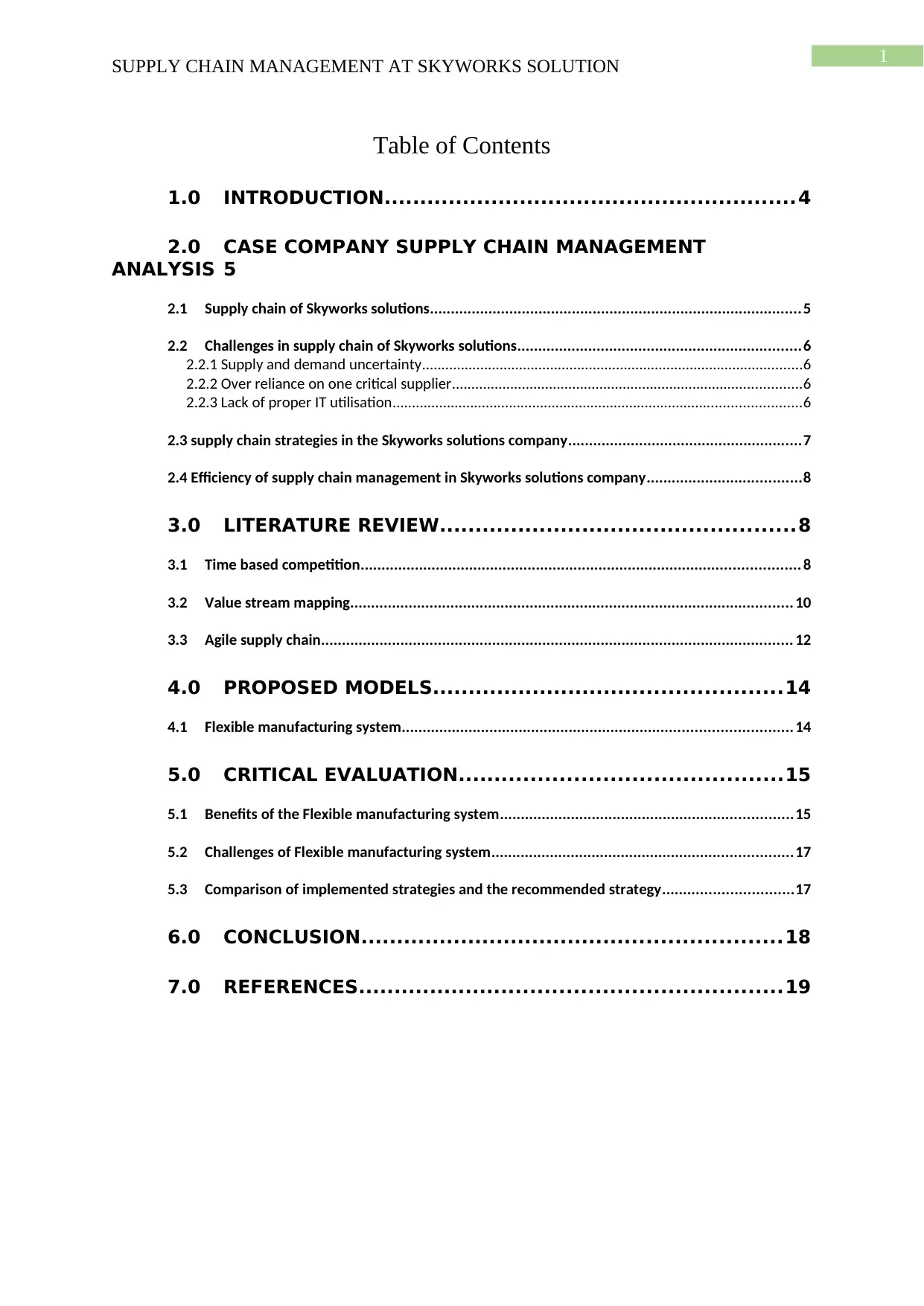
1
SUPPLY CHAIN MANAGEMENT AT SKYWORKS SOLUTION
Table of Contents
1.0 INTRODUCTION..........................................................4
2.0 CASE COMPANY SUPPLY CHAIN MANAGEMENT
ANALYSIS 5
2.1 Supply chain of Skyworks solutions.........................................................................................5
2.2 Challenges in supply chain of Skyworks solutions....................................................................6
2.2.1 Supply and demand uncertainty..................................................................................................6
2.2.2 Over reliance on one critical supplier..........................................................................................6
2.2.3 Lack of proper IT utilisation.........................................................................................................6
2.3 supply chain strategies in the Skyworks solutions company........................................................7
2.4 Efficiency of supply chain management in Skyworks solutions company.....................................8
3.0 LITERATURE REVIEW..................................................8
3.1 Time based competition......................................................................................................... 8
3.2 Value stream mapping.......................................................................................................... 10
3.3 Agile supply chain................................................................................................................. 12
4.0 PROPOSED MODELS.................................................14
4.1 Flexible manufacturing system............................................................................................. 14
5.0 CRITICAL EVALUATION.............................................15
5.1 Benefits of the Flexible manufacturing system......................................................................15
5.2 Challenges of Flexible manufacturing system........................................................................17
5.3 Comparison of implemented strategies and the recommended strategy...............................17
6.0 CONCLUSION...........................................................18
7.0 REFERENCES...........................................................19
SUPPLY CHAIN MANAGEMENT AT SKYWORKS SOLUTION
Table of Contents
1.0 INTRODUCTION..........................................................4
2.0 CASE COMPANY SUPPLY CHAIN MANAGEMENT
ANALYSIS 5
2.1 Supply chain of Skyworks solutions.........................................................................................5
2.2 Challenges in supply chain of Skyworks solutions....................................................................6
2.2.1 Supply and demand uncertainty..................................................................................................6
2.2.2 Over reliance on one critical supplier..........................................................................................6
2.2.3 Lack of proper IT utilisation.........................................................................................................6
2.3 supply chain strategies in the Skyworks solutions company........................................................7
2.4 Efficiency of supply chain management in Skyworks solutions company.....................................8
3.0 LITERATURE REVIEW..................................................8
3.1 Time based competition......................................................................................................... 8
3.2 Value stream mapping.......................................................................................................... 10
3.3 Agile supply chain................................................................................................................. 12
4.0 PROPOSED MODELS.................................................14
4.1 Flexible manufacturing system............................................................................................. 14
5.0 CRITICAL EVALUATION.............................................15
5.1 Benefits of the Flexible manufacturing system......................................................................15
5.2 Challenges of Flexible manufacturing system........................................................................17
5.3 Comparison of implemented strategies and the recommended strategy...............................17
6.0 CONCLUSION...........................................................18
7.0 REFERENCES...........................................................19
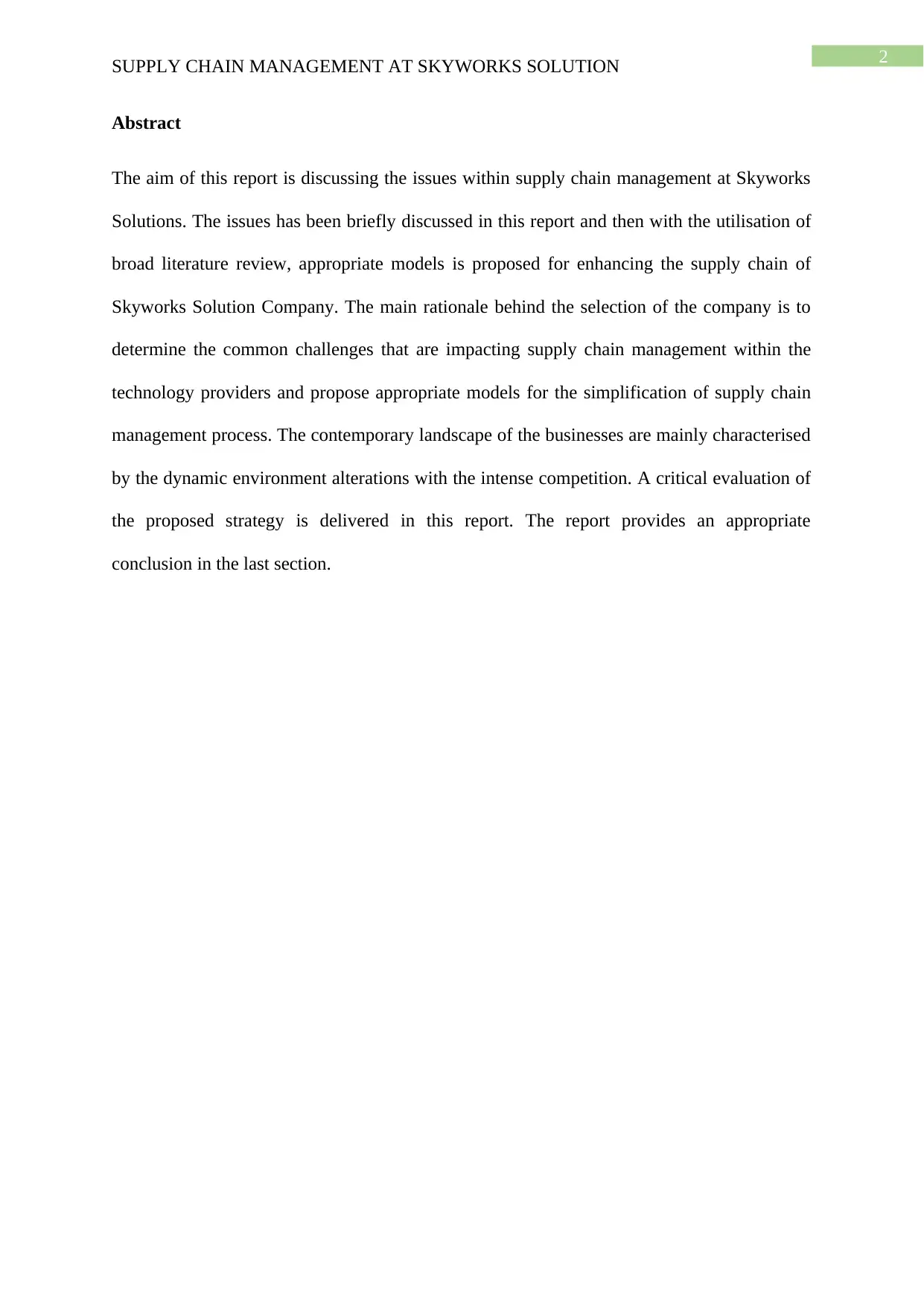
2
SUPPLY CHAIN MANAGEMENT AT SKYWORKS SOLUTION
Abstract
The aim of this report is discussing the issues within supply chain management at Skyworks
Solutions. The issues has been briefly discussed in this report and then with the utilisation of
broad literature review, appropriate models is proposed for enhancing the supply chain of
Skyworks Solution Company. The main rationale behind the selection of the company is to
determine the common challenges that are impacting supply chain management within the
technology providers and propose appropriate models for the simplification of supply chain
management process. The contemporary landscape of the businesses are mainly characterised
by the dynamic environment alterations with the intense competition. A critical evaluation of
the proposed strategy is delivered in this report. The report provides an appropriate
conclusion in the last section.
SUPPLY CHAIN MANAGEMENT AT SKYWORKS SOLUTION
Abstract
The aim of this report is discussing the issues within supply chain management at Skyworks
Solutions. The issues has been briefly discussed in this report and then with the utilisation of
broad literature review, appropriate models is proposed for enhancing the supply chain of
Skyworks Solution Company. The main rationale behind the selection of the company is to
determine the common challenges that are impacting supply chain management within the
technology providers and propose appropriate models for the simplification of supply chain
management process. The contemporary landscape of the businesses are mainly characterised
by the dynamic environment alterations with the intense competition. A critical evaluation of
the proposed strategy is delivered in this report. The report provides an appropriate
conclusion in the last section.
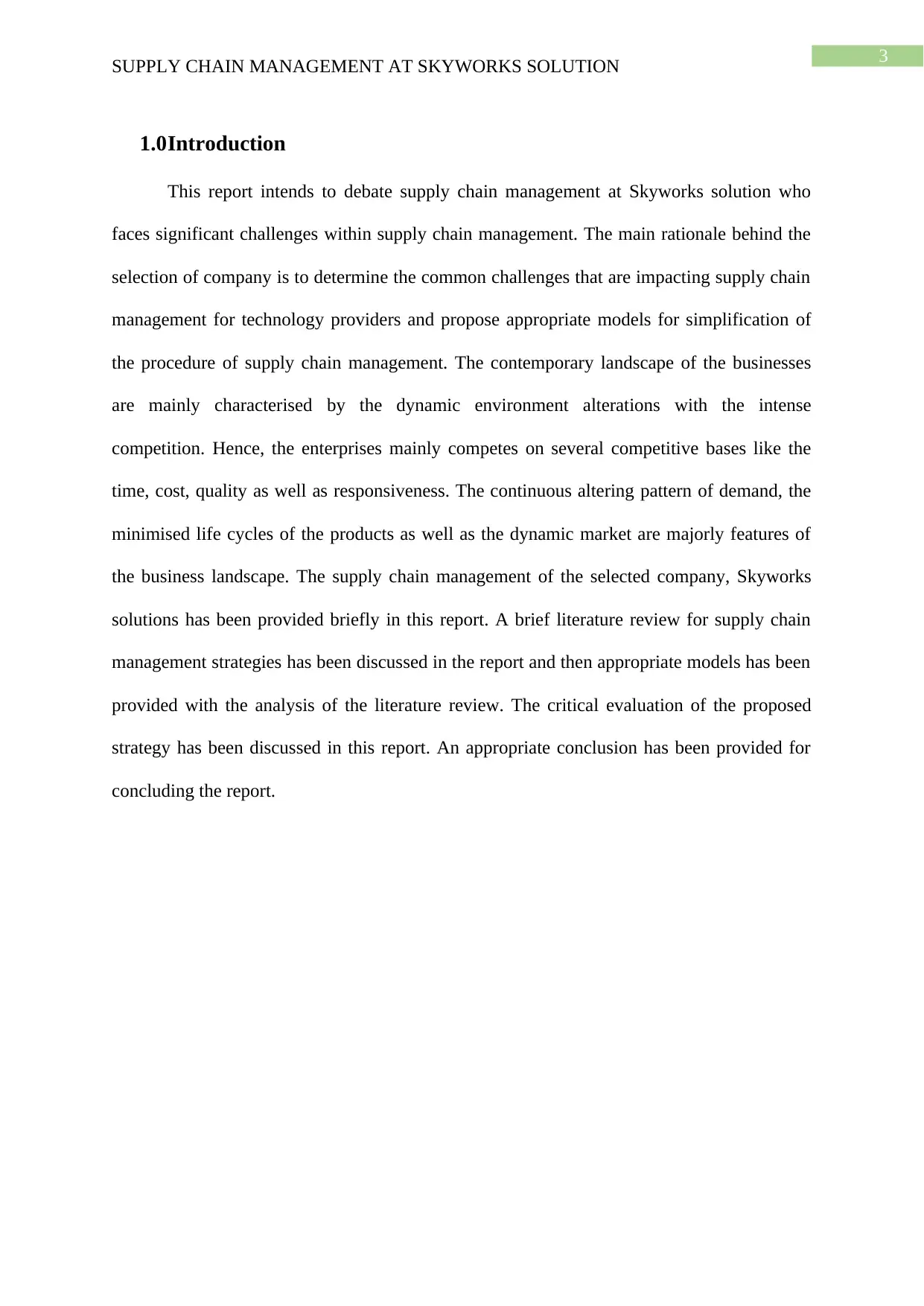
3
SUPPLY CHAIN MANAGEMENT AT SKYWORKS SOLUTION
1.0Introduction
This report intends to debate supply chain management at Skyworks solution who
faces significant challenges within supply chain management. The main rationale behind the
selection of company is to determine the common challenges that are impacting supply chain
management for technology providers and propose appropriate models for simplification of
the procedure of supply chain management. The contemporary landscape of the businesses
are mainly characterised by the dynamic environment alterations with the intense
competition. Hence, the enterprises mainly competes on several competitive bases like the
time, cost, quality as well as responsiveness. The continuous altering pattern of demand, the
minimised life cycles of the products as well as the dynamic market are majorly features of
the business landscape. The supply chain management of the selected company, Skyworks
solutions has been provided briefly in this report. A brief literature review for supply chain
management strategies has been discussed in the report and then appropriate models has been
provided with the analysis of the literature review. The critical evaluation of the proposed
strategy has been discussed in this report. An appropriate conclusion has been provided for
concluding the report.
SUPPLY CHAIN MANAGEMENT AT SKYWORKS SOLUTION
1.0Introduction
This report intends to debate supply chain management at Skyworks solution who
faces significant challenges within supply chain management. The main rationale behind the
selection of company is to determine the common challenges that are impacting supply chain
management for technology providers and propose appropriate models for simplification of
the procedure of supply chain management. The contemporary landscape of the businesses
are mainly characterised by the dynamic environment alterations with the intense
competition. Hence, the enterprises mainly competes on several competitive bases like the
time, cost, quality as well as responsiveness. The continuous altering pattern of demand, the
minimised life cycles of the products as well as the dynamic market are majorly features of
the business landscape. The supply chain management of the selected company, Skyworks
solutions has been provided briefly in this report. A brief literature review for supply chain
management strategies has been discussed in the report and then appropriate models has been
provided with the analysis of the literature review. The critical evaluation of the proposed
strategy has been discussed in this report. An appropriate conclusion has been provided for
concluding the report.
Secure Best Marks with AI Grader
Need help grading? Try our AI Grader for instant feedback on your assignments.
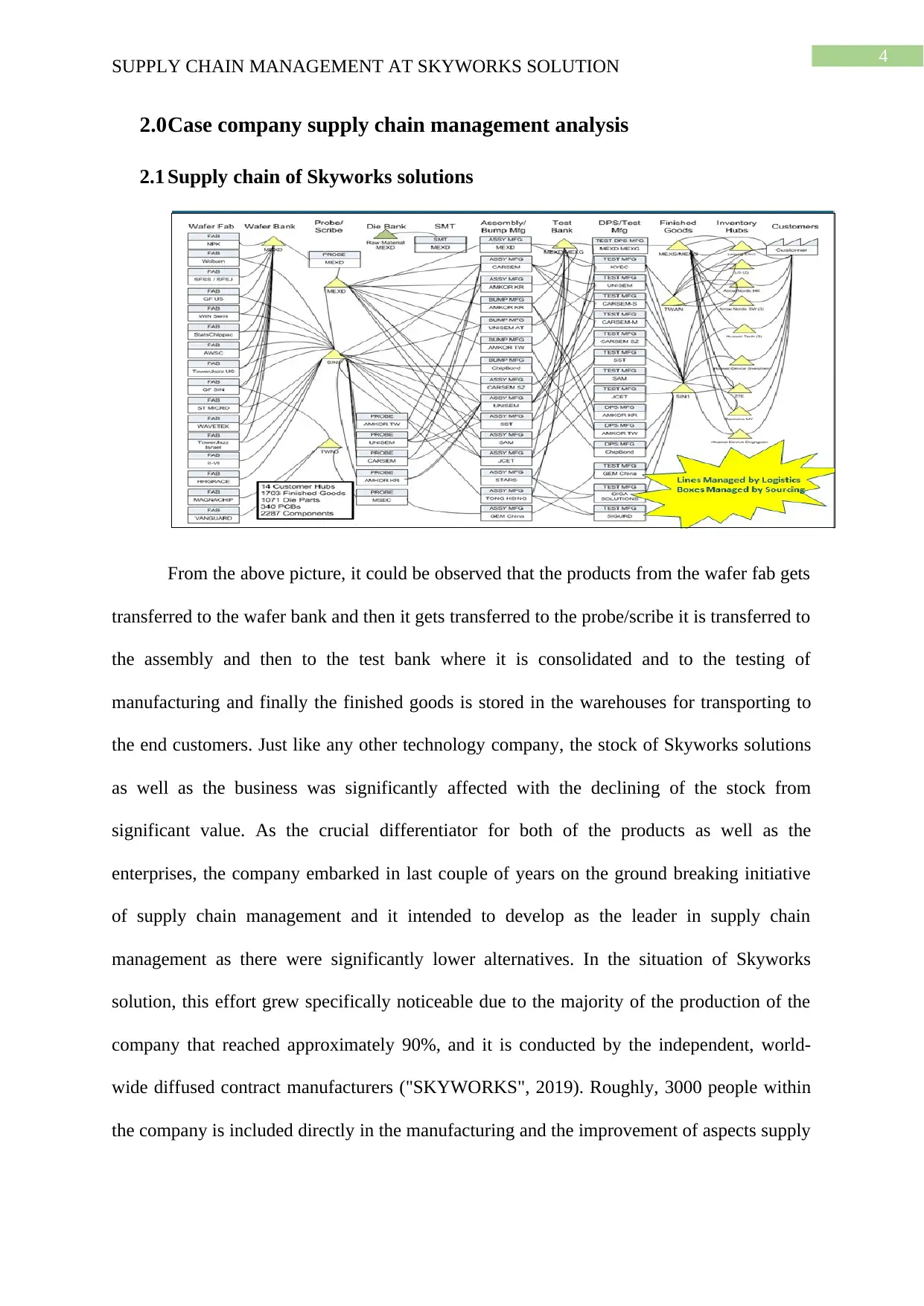
4
SUPPLY CHAIN MANAGEMENT AT SKYWORKS SOLUTION
2.0Case company supply chain management analysis
2.1 Supply chain of Skyworks solutions
From the above picture, it could be observed that the products from the wafer fab gets
transferred to the wafer bank and then it gets transferred to the probe/scribe it is transferred to
the assembly and then to the test bank where it is consolidated and to the testing of
manufacturing and finally the finished goods is stored in the warehouses for transporting to
the end customers. Just like any other technology company, the stock of Skyworks solutions
as well as the business was significantly affected with the declining of the stock from
significant value. As the crucial differentiator for both of the products as well as the
enterprises, the company embarked in last couple of years on the ground breaking initiative
of supply chain management and it intended to develop as the leader in supply chain
management as there were significantly lower alternatives. In the situation of Skyworks
solution, this effort grew specifically noticeable due to the majority of the production of the
company that reached approximately 90%, and it is conducted by the independent, world-
wide diffused contract manufacturers ("SKYWORKS", 2019). Roughly, 3000 people within
the company is included directly in the manufacturing and the improvement of aspects supply
SUPPLY CHAIN MANAGEMENT AT SKYWORKS SOLUTION
2.0Case company supply chain management analysis
2.1 Supply chain of Skyworks solutions
From the above picture, it could be observed that the products from the wafer fab gets
transferred to the wafer bank and then it gets transferred to the probe/scribe it is transferred to
the assembly and then to the test bank where it is consolidated and to the testing of
manufacturing and finally the finished goods is stored in the warehouses for transporting to
the end customers. Just like any other technology company, the stock of Skyworks solutions
as well as the business was significantly affected with the declining of the stock from
significant value. As the crucial differentiator for both of the products as well as the
enterprises, the company embarked in last couple of years on the ground breaking initiative
of supply chain management and it intended to develop as the leader in supply chain
management as there were significantly lower alternatives. In the situation of Skyworks
solution, this effort grew specifically noticeable due to the majority of the production of the
company that reached approximately 90%, and it is conducted by the independent, world-
wide diffused contract manufacturers ("SKYWORKS", 2019). Roughly, 3000 people within
the company is included directly in the manufacturing and the improvement of aspects supply
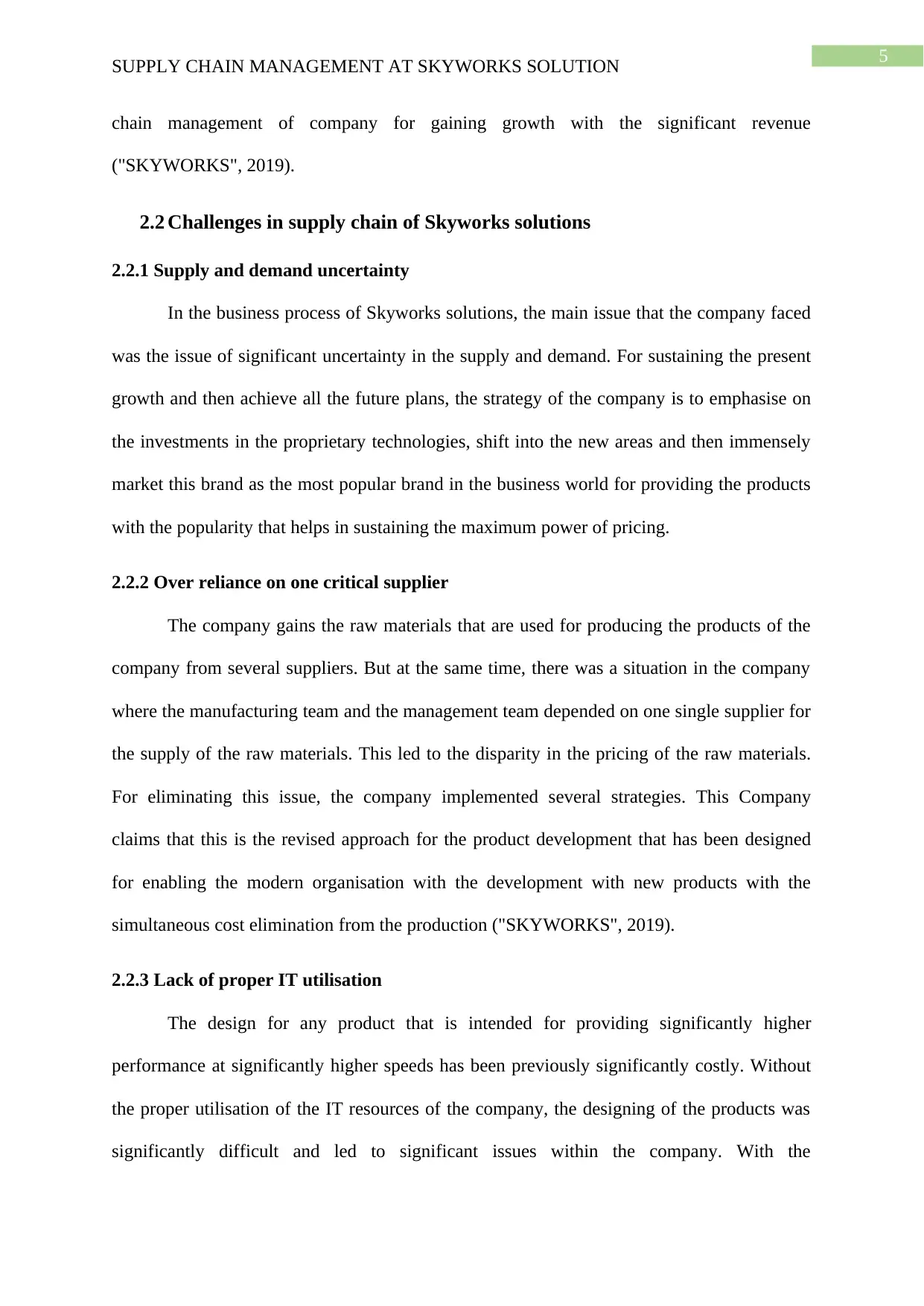
5
SUPPLY CHAIN MANAGEMENT AT SKYWORKS SOLUTION
chain management of company for gaining growth with the significant revenue
("SKYWORKS", 2019).
2.2 Challenges in supply chain of Skyworks solutions
2.2.1 Supply and demand uncertainty
In the business process of Skyworks solutions, the main issue that the company faced
was the issue of significant uncertainty in the supply and demand. For sustaining the present
growth and then achieve all the future plans, the strategy of the company is to emphasise on
the investments in the proprietary technologies, shift into the new areas and then immensely
market this brand as the most popular brand in the business world for providing the products
with the popularity that helps in sustaining the maximum power of pricing.
2.2.2 Over reliance on one critical supplier
The company gains the raw materials that are used for producing the products of the
company from several suppliers. But at the same time, there was a situation in the company
where the manufacturing team and the management team depended on one single supplier for
the supply of the raw materials. This led to the disparity in the pricing of the raw materials.
For eliminating this issue, the company implemented several strategies. This Company
claims that this is the revised approach for the product development that has been designed
for enabling the modern organisation with the development with new products with the
simultaneous cost elimination from the production ("SKYWORKS", 2019).
2.2.3 Lack of proper IT utilisation
The design for any product that is intended for providing significantly higher
performance at significantly higher speeds has been previously significantly costly. Without
the proper utilisation of the IT resources of the company, the designing of the products was
significantly difficult and led to significant issues within the company. With the
SUPPLY CHAIN MANAGEMENT AT SKYWORKS SOLUTION
chain management of company for gaining growth with the significant revenue
("SKYWORKS", 2019).
2.2 Challenges in supply chain of Skyworks solutions
2.2.1 Supply and demand uncertainty
In the business process of Skyworks solutions, the main issue that the company faced
was the issue of significant uncertainty in the supply and demand. For sustaining the present
growth and then achieve all the future plans, the strategy of the company is to emphasise on
the investments in the proprietary technologies, shift into the new areas and then immensely
market this brand as the most popular brand in the business world for providing the products
with the popularity that helps in sustaining the maximum power of pricing.
2.2.2 Over reliance on one critical supplier
The company gains the raw materials that are used for producing the products of the
company from several suppliers. But at the same time, there was a situation in the company
where the manufacturing team and the management team depended on one single supplier for
the supply of the raw materials. This led to the disparity in the pricing of the raw materials.
For eliminating this issue, the company implemented several strategies. This Company
claims that this is the revised approach for the product development that has been designed
for enabling the modern organisation with the development with new products with the
simultaneous cost elimination from the production ("SKYWORKS", 2019).
2.2.3 Lack of proper IT utilisation
The design for any product that is intended for providing significantly higher
performance at significantly higher speeds has been previously significantly costly. Without
the proper utilisation of the IT resources of the company, the designing of the products was
significantly difficult and led to significant issues within the company. With the
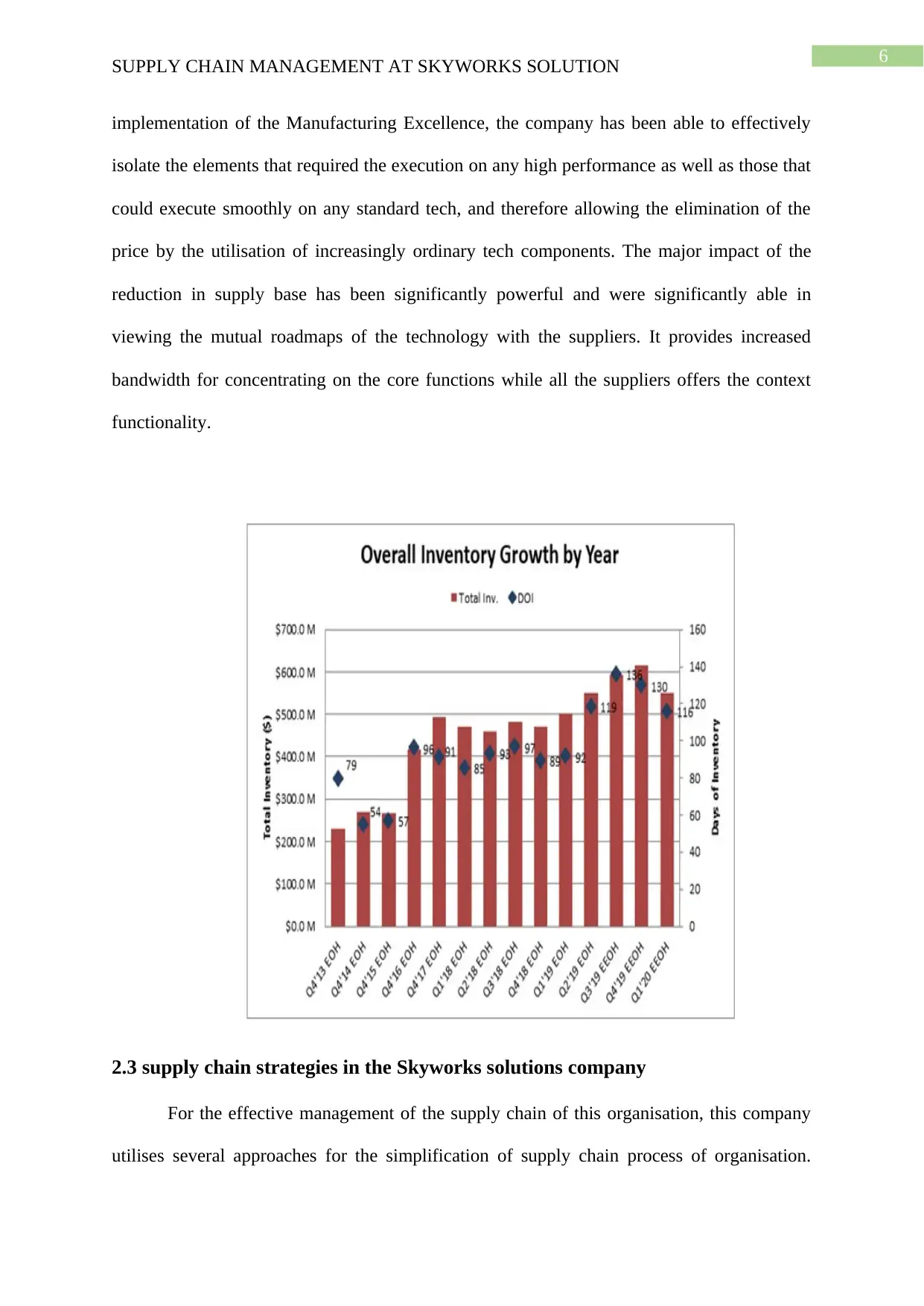
6
SUPPLY CHAIN MANAGEMENT AT SKYWORKS SOLUTION
implementation of the Manufacturing Excellence, the company has been able to effectively
isolate the elements that required the execution on any high performance as well as those that
could execute smoothly on any standard tech, and therefore allowing the elimination of the
price by the utilisation of increasingly ordinary tech components. The major impact of the
reduction in supply base has been significantly powerful and were significantly able in
viewing the mutual roadmaps of the technology with the suppliers. It provides increased
bandwidth for concentrating on the core functions while all the suppliers offers the context
functionality.
2.3 supply chain strategies in the Skyworks solutions company
For the effective management of the supply chain of this organisation, this company
utilises several approaches for the simplification of supply chain process of organisation.
SUPPLY CHAIN MANAGEMENT AT SKYWORKS SOLUTION
implementation of the Manufacturing Excellence, the company has been able to effectively
isolate the elements that required the execution on any high performance as well as those that
could execute smoothly on any standard tech, and therefore allowing the elimination of the
price by the utilisation of increasingly ordinary tech components. The major impact of the
reduction in supply base has been significantly powerful and were significantly able in
viewing the mutual roadmaps of the technology with the suppliers. It provides increased
bandwidth for concentrating on the core functions while all the suppliers offers the context
functionality.
2.3 supply chain strategies in the Skyworks solutions company
For the effective management of the supply chain of this organisation, this company
utilises several approaches for the simplification of supply chain process of organisation.
Paraphrase This Document
Need a fresh take? Get an instant paraphrase of this document with our AI Paraphraser
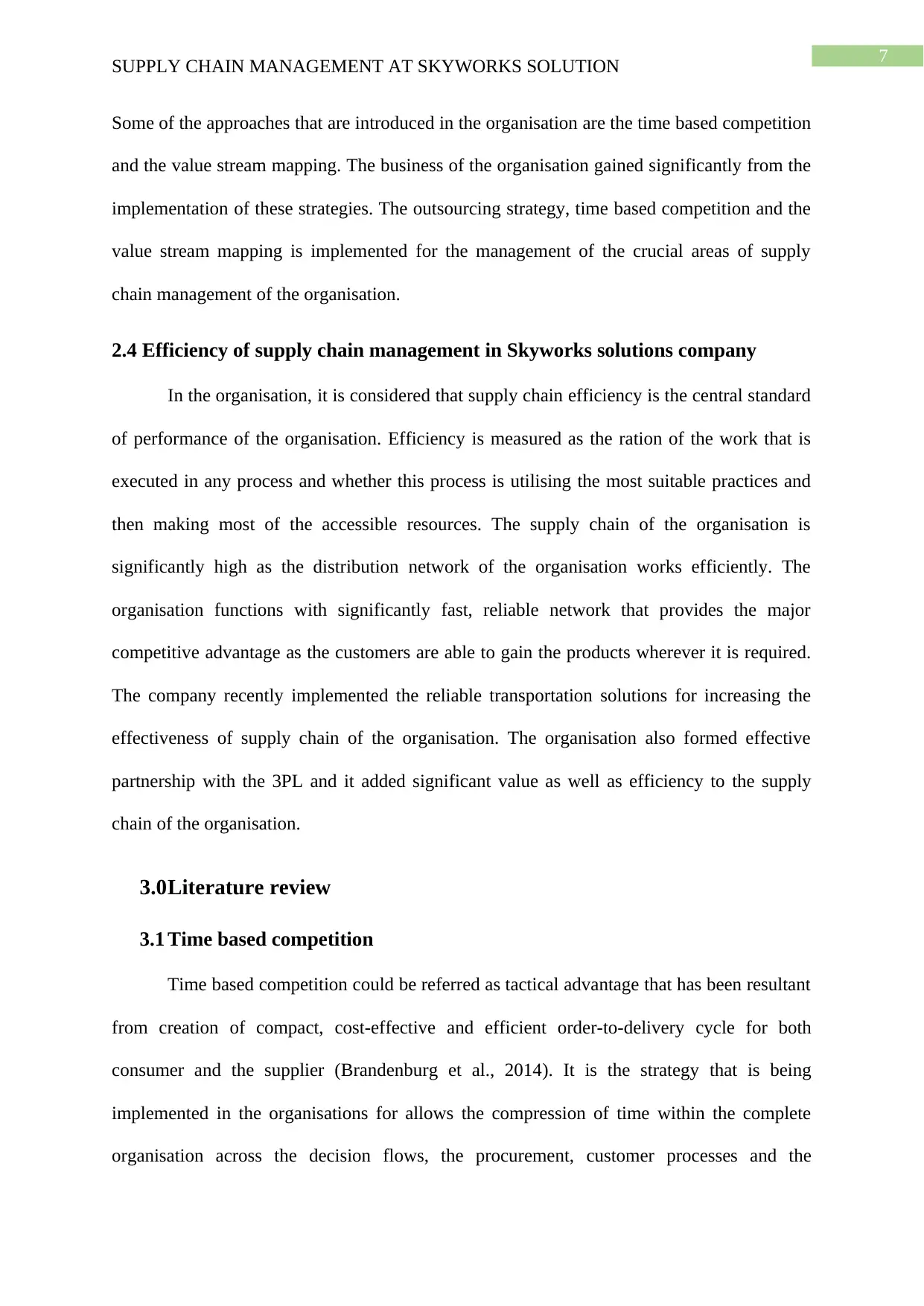
7
SUPPLY CHAIN MANAGEMENT AT SKYWORKS SOLUTION
Some of the approaches that are introduced in the organisation are the time based competition
and the value stream mapping. The business of the organisation gained significantly from the
implementation of these strategies. The outsourcing strategy, time based competition and the
value stream mapping is implemented for the management of the crucial areas of supply
chain management of the organisation.
2.4 Efficiency of supply chain management in Skyworks solutions company
In the organisation, it is considered that supply chain efficiency is the central standard
of performance of the organisation. Efficiency is measured as the ration of the work that is
executed in any process and whether this process is utilising the most suitable practices and
then making most of the accessible resources. The supply chain of the organisation is
significantly high as the distribution network of the organisation works efficiently. The
organisation functions with significantly fast, reliable network that provides the major
competitive advantage as the customers are able to gain the products wherever it is required.
The company recently implemented the reliable transportation solutions for increasing the
effectiveness of supply chain of the organisation. The organisation also formed effective
partnership with the 3PL and it added significant value as well as efficiency to the supply
chain of the organisation.
3.0Literature review
3.1 Time based competition
Time based competition could be referred as tactical advantage that has been resultant
from creation of compact, cost-effective and efficient order-to-delivery cycle for both
consumer and the supplier (Brandenburg et al., 2014). It is the strategy that is being
implemented in the organisations for allows the compression of time within the complete
organisation across the decision flows, the procurement, customer processes and the
SUPPLY CHAIN MANAGEMENT AT SKYWORKS SOLUTION
Some of the approaches that are introduced in the organisation are the time based competition
and the value stream mapping. The business of the organisation gained significantly from the
implementation of these strategies. The outsourcing strategy, time based competition and the
value stream mapping is implemented for the management of the crucial areas of supply
chain management of the organisation.
2.4 Efficiency of supply chain management in Skyworks solutions company
In the organisation, it is considered that supply chain efficiency is the central standard
of performance of the organisation. Efficiency is measured as the ration of the work that is
executed in any process and whether this process is utilising the most suitable practices and
then making most of the accessible resources. The supply chain of the organisation is
significantly high as the distribution network of the organisation works efficiently. The
organisation functions with significantly fast, reliable network that provides the major
competitive advantage as the customers are able to gain the products wherever it is required.
The company recently implemented the reliable transportation solutions for increasing the
effectiveness of supply chain of the organisation. The organisation also formed effective
partnership with the 3PL and it added significant value as well as efficiency to the supply
chain of the organisation.
3.0Literature review
3.1 Time based competition
Time based competition could be referred as tactical advantage that has been resultant
from creation of compact, cost-effective and efficient order-to-delivery cycle for both
consumer and the supplier (Brandenburg et al., 2014). It is the strategy that is being
implemented in the organisations for allows the compression of time within the complete
organisation across the decision flows, the procurement, customer processes and the
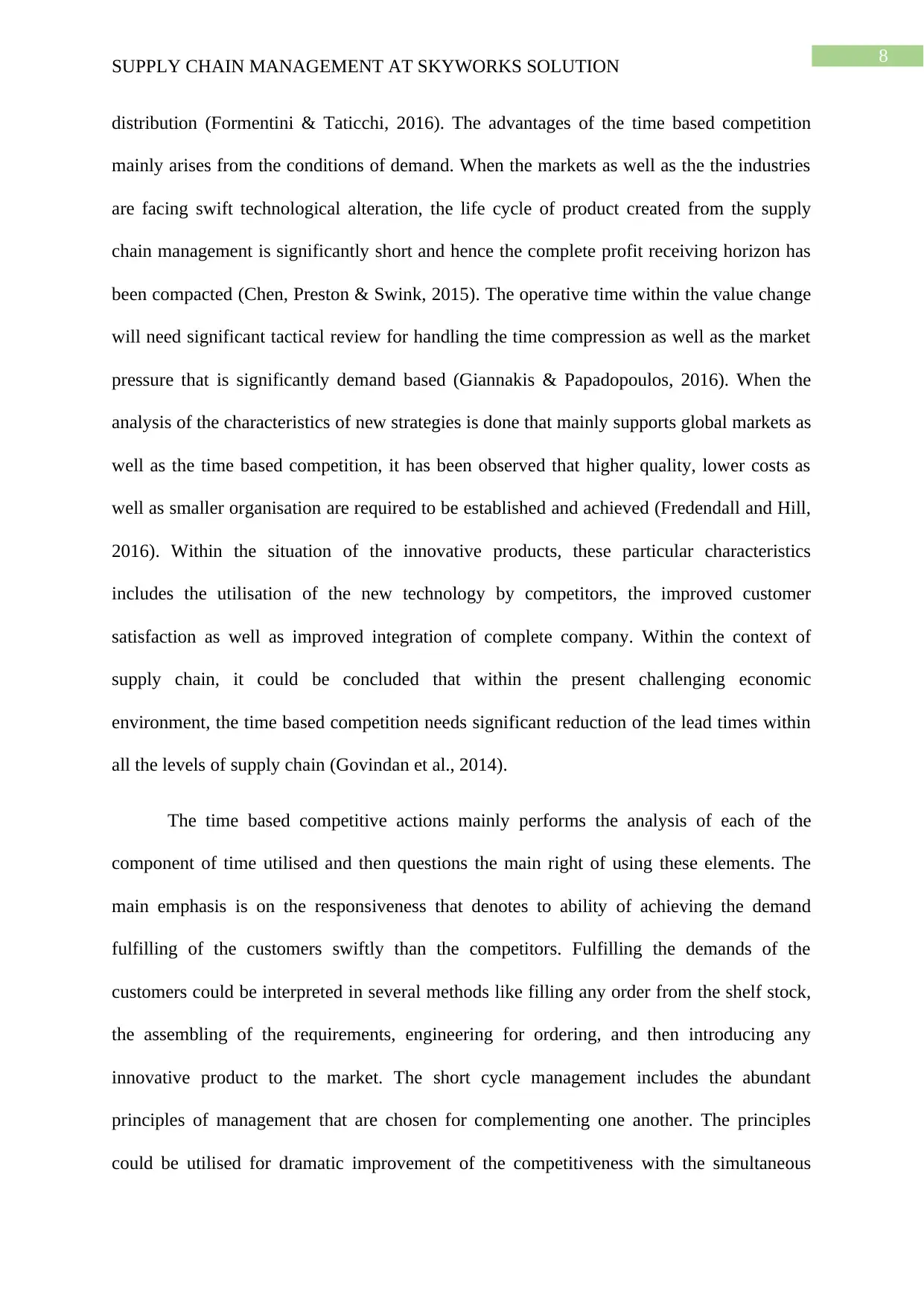
8
SUPPLY CHAIN MANAGEMENT AT SKYWORKS SOLUTION
distribution (Formentini & Taticchi, 2016). The advantages of the time based competition
mainly arises from the conditions of demand. When the markets as well as the the industries
are facing swift technological alteration, the life cycle of product created from the supply
chain management is significantly short and hence the complete profit receiving horizon has
been compacted (Chen, Preston & Swink, 2015). The operative time within the value change
will need significant tactical review for handling the time compression as well as the market
pressure that is significantly demand based (Giannakis & Papadopoulos, 2016). When the
analysis of the characteristics of new strategies is done that mainly supports global markets as
well as the time based competition, it has been observed that higher quality, lower costs as
well as smaller organisation are required to be established and achieved (Fredendall and Hill,
2016). Within the situation of the innovative products, these particular characteristics
includes the utilisation of the new technology by competitors, the improved customer
satisfaction as well as improved integration of complete company. Within the context of
supply chain, it could be concluded that within the present challenging economic
environment, the time based competition needs significant reduction of the lead times within
all the levels of supply chain (Govindan et al., 2014).
The time based competitive actions mainly performs the analysis of each of the
component of time utilised and then questions the main right of using these elements. The
main emphasis is on the responsiveness that denotes to ability of achieving the demand
fulfilling of the customers swiftly than the competitors. Fulfilling the demands of the
customers could be interpreted in several methods like filling any order from the shelf stock,
the assembling of the requirements, engineering for ordering, and then introducing any
innovative product to the market. The short cycle management includes the abundant
principles of management that are chosen for complementing one another. The principles
could be utilised for dramatic improvement of the competitiveness with the simultaneous
SUPPLY CHAIN MANAGEMENT AT SKYWORKS SOLUTION
distribution (Formentini & Taticchi, 2016). The advantages of the time based competition
mainly arises from the conditions of demand. When the markets as well as the the industries
are facing swift technological alteration, the life cycle of product created from the supply
chain management is significantly short and hence the complete profit receiving horizon has
been compacted (Chen, Preston & Swink, 2015). The operative time within the value change
will need significant tactical review for handling the time compression as well as the market
pressure that is significantly demand based (Giannakis & Papadopoulos, 2016). When the
analysis of the characteristics of new strategies is done that mainly supports global markets as
well as the time based competition, it has been observed that higher quality, lower costs as
well as smaller organisation are required to be established and achieved (Fredendall and Hill,
2016). Within the situation of the innovative products, these particular characteristics
includes the utilisation of the new technology by competitors, the improved customer
satisfaction as well as improved integration of complete company. Within the context of
supply chain, it could be concluded that within the present challenging economic
environment, the time based competition needs significant reduction of the lead times within
all the levels of supply chain (Govindan et al., 2014).
The time based competitive actions mainly performs the analysis of each of the
component of time utilised and then questions the main right of using these elements. The
main emphasis is on the responsiveness that denotes to ability of achieving the demand
fulfilling of the customers swiftly than the competitors. Fulfilling the demands of the
customers could be interpreted in several methods like filling any order from the shelf stock,
the assembling of the requirements, engineering for ordering, and then introducing any
innovative product to the market. The short cycle management includes the abundant
principles of management that are chosen for complementing one another. The principles
could be utilised for dramatic improvement of the competitiveness with the simultaneous
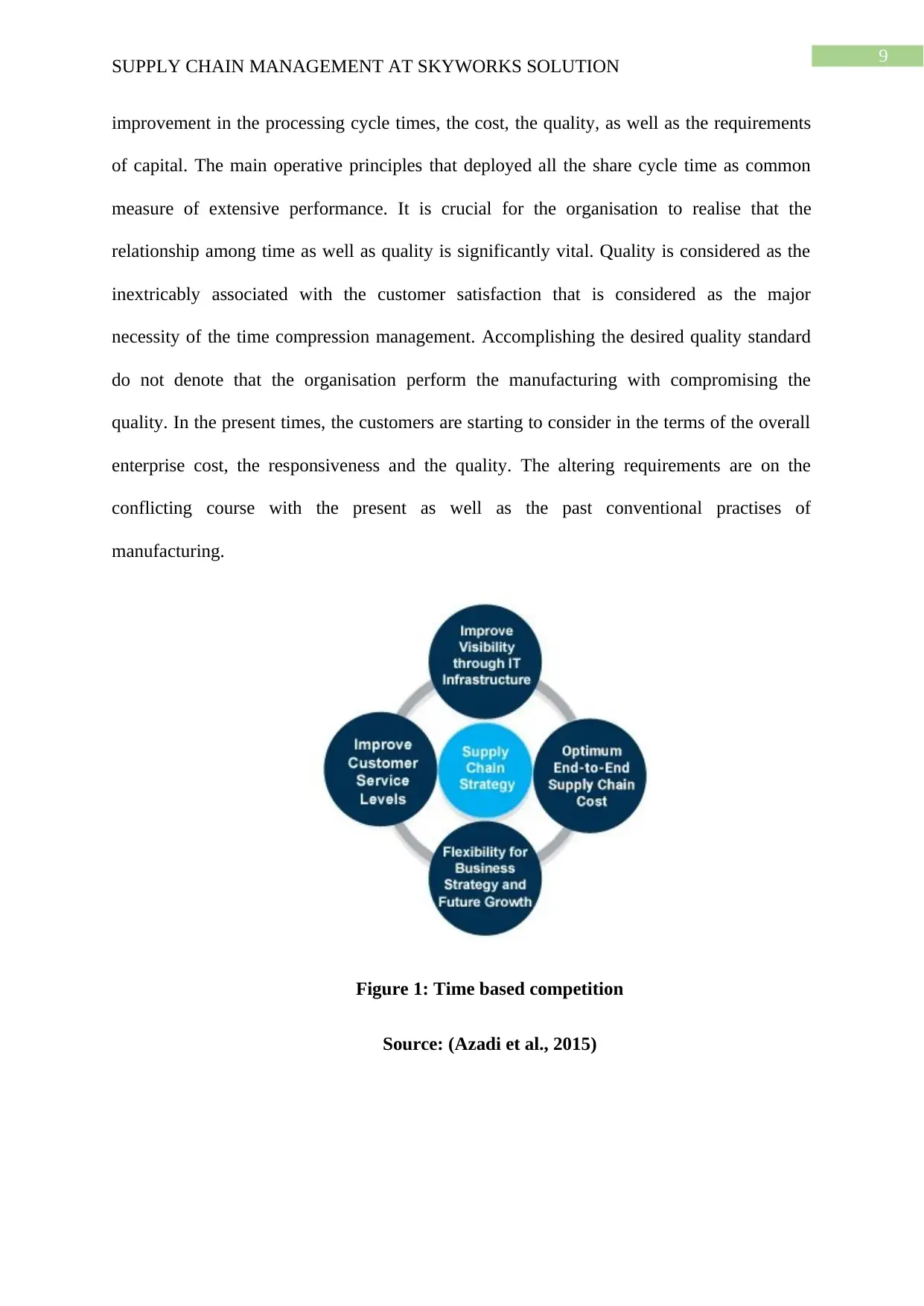
9
SUPPLY CHAIN MANAGEMENT AT SKYWORKS SOLUTION
improvement in the processing cycle times, the cost, the quality, as well as the requirements
of capital. The main operative principles that deployed all the share cycle time as common
measure of extensive performance. It is crucial for the organisation to realise that the
relationship among time as well as quality is significantly vital. Quality is considered as the
inextricably associated with the customer satisfaction that is considered as the major
necessity of the time compression management. Accomplishing the desired quality standard
do not denote that the organisation perform the manufacturing with compromising the
quality. In the present times, the customers are starting to consider in the terms of the overall
enterprise cost, the responsiveness and the quality. The altering requirements are on the
conflicting course with the present as well as the past conventional practises of
manufacturing.
Figure 1: Time based competition
Source: (Azadi et al., 2015)
SUPPLY CHAIN MANAGEMENT AT SKYWORKS SOLUTION
improvement in the processing cycle times, the cost, the quality, as well as the requirements
of capital. The main operative principles that deployed all the share cycle time as common
measure of extensive performance. It is crucial for the organisation to realise that the
relationship among time as well as quality is significantly vital. Quality is considered as the
inextricably associated with the customer satisfaction that is considered as the major
necessity of the time compression management. Accomplishing the desired quality standard
do not denote that the organisation perform the manufacturing with compromising the
quality. In the present times, the customers are starting to consider in the terms of the overall
enterprise cost, the responsiveness and the quality. The altering requirements are on the
conflicting course with the present as well as the past conventional practises of
manufacturing.
Figure 1: Time based competition
Source: (Azadi et al., 2015)
Secure Best Marks with AI Grader
Need help grading? Try our AI Grader for instant feedback on your assignments.
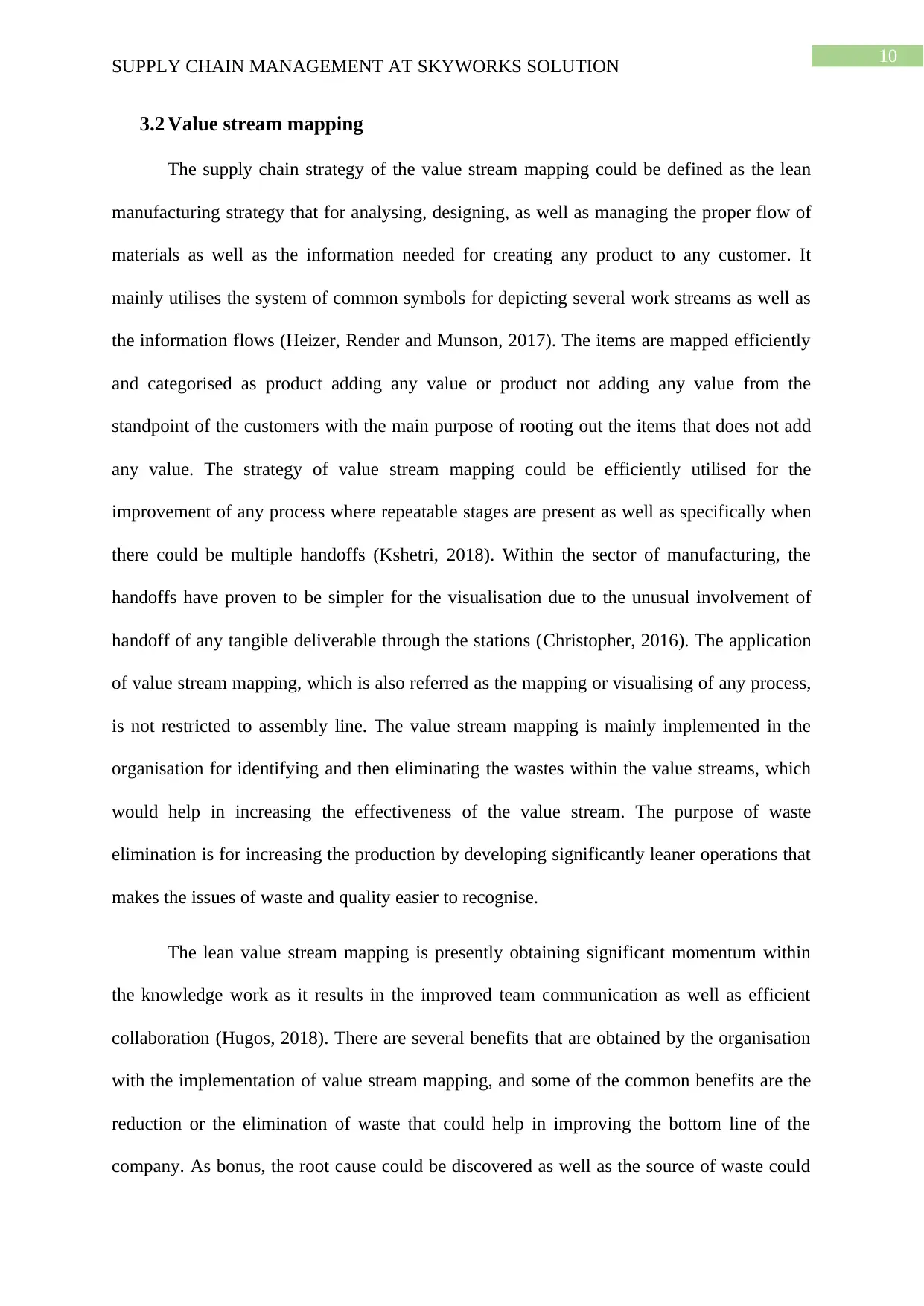
10
SUPPLY CHAIN MANAGEMENT AT SKYWORKS SOLUTION
3.2 Value stream mapping
The supply chain strategy of the value stream mapping could be defined as the lean
manufacturing strategy that for analysing, designing, as well as managing the proper flow of
materials as well as the information needed for creating any product to any customer. It
mainly utilises the system of common symbols for depicting several work streams as well as
the information flows (Heizer, Render and Munson, 2017). The items are mapped efficiently
and categorised as product adding any value or product not adding any value from the
standpoint of the customers with the main purpose of rooting out the items that does not add
any value. The strategy of value stream mapping could be efficiently utilised for the
improvement of any process where repeatable stages are present as well as specifically when
there could be multiple handoffs (Kshetri, 2018). Within the sector of manufacturing, the
handoffs have proven to be simpler for the visualisation due to the unusual involvement of
handoff of any tangible deliverable through the stations (Christopher, 2016). The application
of value stream mapping, which is also referred as the mapping or visualising of any process,
is not restricted to assembly line. The value stream mapping is mainly implemented in the
organisation for identifying and then eliminating the wastes within the value streams, which
would help in increasing the effectiveness of the value stream. The purpose of waste
elimination is for increasing the production by developing significantly leaner operations that
makes the issues of waste and quality easier to recognise.
The lean value stream mapping is presently obtaining significant momentum within
the knowledge work as it results in the improved team communication as well as efficient
collaboration (Hugos, 2018). There are several benefits that are obtained by the organisation
with the implementation of value stream mapping, and some of the common benefits are the
reduction or the elimination of waste that could help in improving the bottom line of the
company. As bonus, the root cause could be discovered as well as the source of waste could
SUPPLY CHAIN MANAGEMENT AT SKYWORKS SOLUTION
3.2 Value stream mapping
The supply chain strategy of the value stream mapping could be defined as the lean
manufacturing strategy that for analysing, designing, as well as managing the proper flow of
materials as well as the information needed for creating any product to any customer. It
mainly utilises the system of common symbols for depicting several work streams as well as
the information flows (Heizer, Render and Munson, 2017). The items are mapped efficiently
and categorised as product adding any value or product not adding any value from the
standpoint of the customers with the main purpose of rooting out the items that does not add
any value. The strategy of value stream mapping could be efficiently utilised for the
improvement of any process where repeatable stages are present as well as specifically when
there could be multiple handoffs (Kshetri, 2018). Within the sector of manufacturing, the
handoffs have proven to be simpler for the visualisation due to the unusual involvement of
handoff of any tangible deliverable through the stations (Christopher, 2016). The application
of value stream mapping, which is also referred as the mapping or visualising of any process,
is not restricted to assembly line. The value stream mapping is mainly implemented in the
organisation for identifying and then eliminating the wastes within the value streams, which
would help in increasing the effectiveness of the value stream. The purpose of waste
elimination is for increasing the production by developing significantly leaner operations that
makes the issues of waste and quality easier to recognise.
The lean value stream mapping is presently obtaining significant momentum within
the knowledge work as it results in the improved team communication as well as efficient
collaboration (Hugos, 2018). There are several benefits that are obtained by the organisation
with the implementation of value stream mapping, and some of the common benefits are the
reduction or the elimination of waste that could help in improving the bottom line of the
company. As bonus, the root cause could be discovered as well as the source of waste could
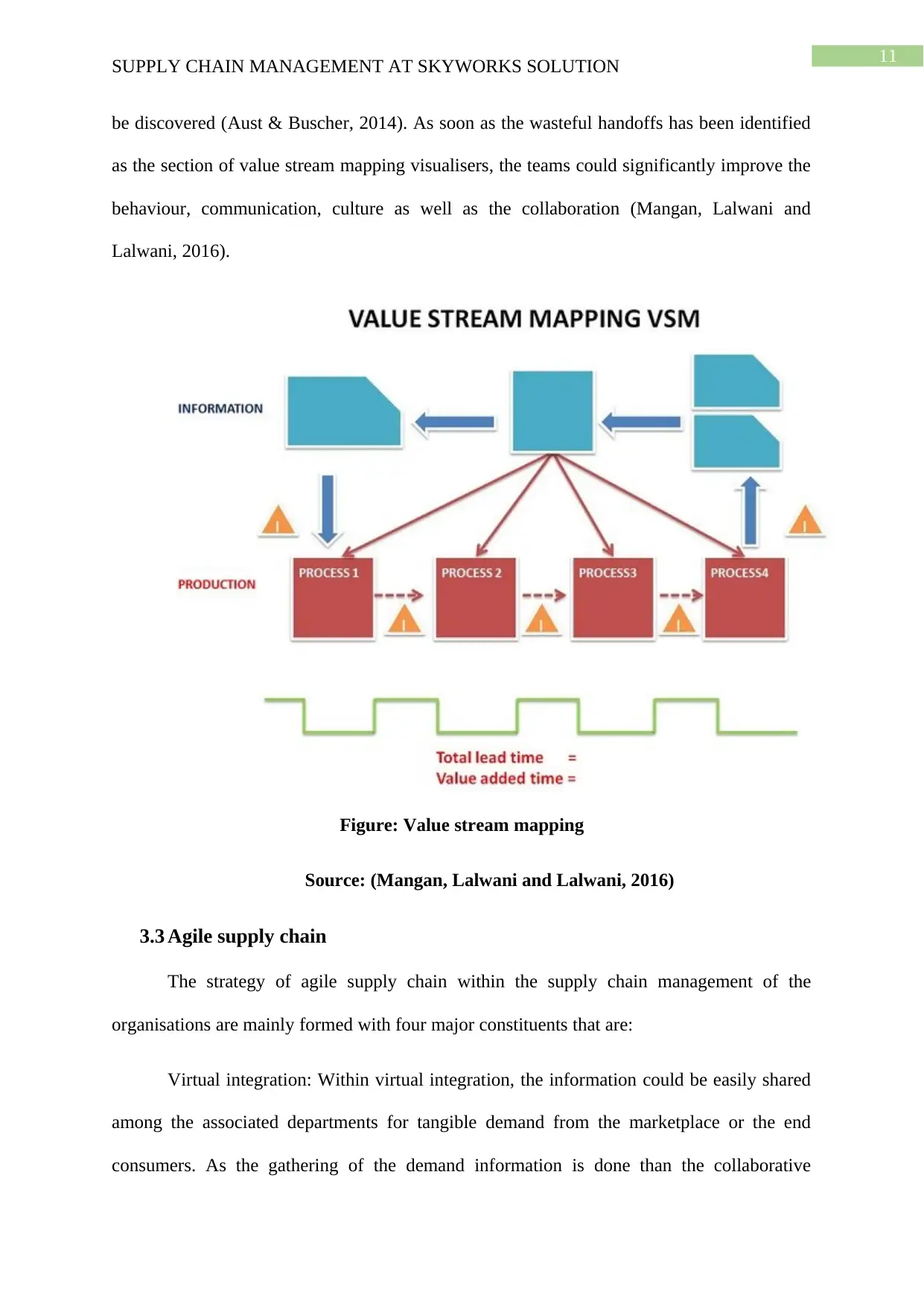
11
SUPPLY CHAIN MANAGEMENT AT SKYWORKS SOLUTION
be discovered (Aust & Buscher, 2014). As soon as the wasteful handoffs has been identified
as the section of value stream mapping visualisers, the teams could significantly improve the
behaviour, communication, culture as well as the collaboration (Mangan, Lalwani and
Lalwani, 2016).
Figure: Value stream mapping
Source: (Mangan, Lalwani and Lalwani, 2016)
3.3 Agile supply chain
The strategy of agile supply chain within the supply chain management of the
organisations are mainly formed with four major constituents that are:
Virtual integration: Within virtual integration, the information could be easily shared
among the associated departments for tangible demand from the marketplace or the end
consumers. As the gathering of the demand information is done than the collaborative
SUPPLY CHAIN MANAGEMENT AT SKYWORKS SOLUTION
be discovered (Aust & Buscher, 2014). As soon as the wasteful handoffs has been identified
as the section of value stream mapping visualisers, the teams could significantly improve the
behaviour, communication, culture as well as the collaboration (Mangan, Lalwani and
Lalwani, 2016).
Figure: Value stream mapping
Source: (Mangan, Lalwani and Lalwani, 2016)
3.3 Agile supply chain
The strategy of agile supply chain within the supply chain management of the
organisations are mainly formed with four major constituents that are:
Virtual integration: Within virtual integration, the information could be easily shared
among the associated departments for tangible demand from the marketplace or the end
consumers. As the gathering of the demand information is done than the collaborative
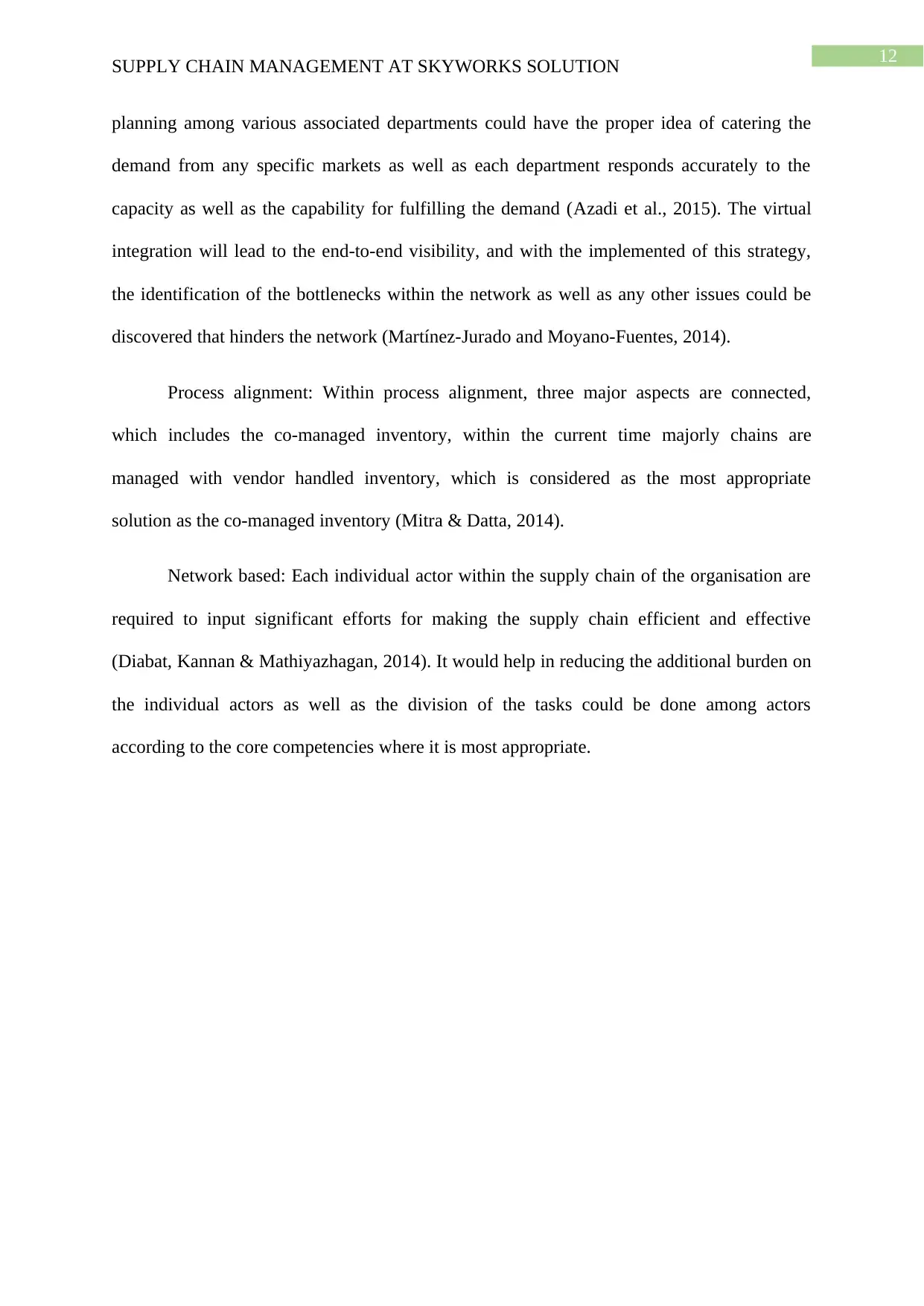
12
SUPPLY CHAIN MANAGEMENT AT SKYWORKS SOLUTION
planning among various associated departments could have the proper idea of catering the
demand from any specific markets as well as each department responds accurately to the
capacity as well as the capability for fulfilling the demand (Azadi et al., 2015). The virtual
integration will lead to the end-to-end visibility, and with the implemented of this strategy,
the identification of the bottlenecks within the network as well as any other issues could be
discovered that hinders the network (Martínez-Jurado and Moyano-Fuentes, 2014).
Process alignment: Within process alignment, three major aspects are connected,
which includes the co-managed inventory, within the current time majorly chains are
managed with vendor handled inventory, which is considered as the most appropriate
solution as the co-managed inventory (Mitra & Datta, 2014).
Network based: Each individual actor within the supply chain of the organisation are
required to input significant efforts for making the supply chain efficient and effective
(Diabat, Kannan & Mathiyazhagan, 2014). It would help in reducing the additional burden on
the individual actors as well as the division of the tasks could be done among actors
according to the core competencies where it is most appropriate.
SUPPLY CHAIN MANAGEMENT AT SKYWORKS SOLUTION
planning among various associated departments could have the proper idea of catering the
demand from any specific markets as well as each department responds accurately to the
capacity as well as the capability for fulfilling the demand (Azadi et al., 2015). The virtual
integration will lead to the end-to-end visibility, and with the implemented of this strategy,
the identification of the bottlenecks within the network as well as any other issues could be
discovered that hinders the network (Martínez-Jurado and Moyano-Fuentes, 2014).
Process alignment: Within process alignment, three major aspects are connected,
which includes the co-managed inventory, within the current time majorly chains are
managed with vendor handled inventory, which is considered as the most appropriate
solution as the co-managed inventory (Mitra & Datta, 2014).
Network based: Each individual actor within the supply chain of the organisation are
required to input significant efforts for making the supply chain efficient and effective
(Diabat, Kannan & Mathiyazhagan, 2014). It would help in reducing the additional burden on
the individual actors as well as the division of the tasks could be done among actors
according to the core competencies where it is most appropriate.
Paraphrase This Document
Need a fresh take? Get an instant paraphrase of this document with our AI Paraphraser
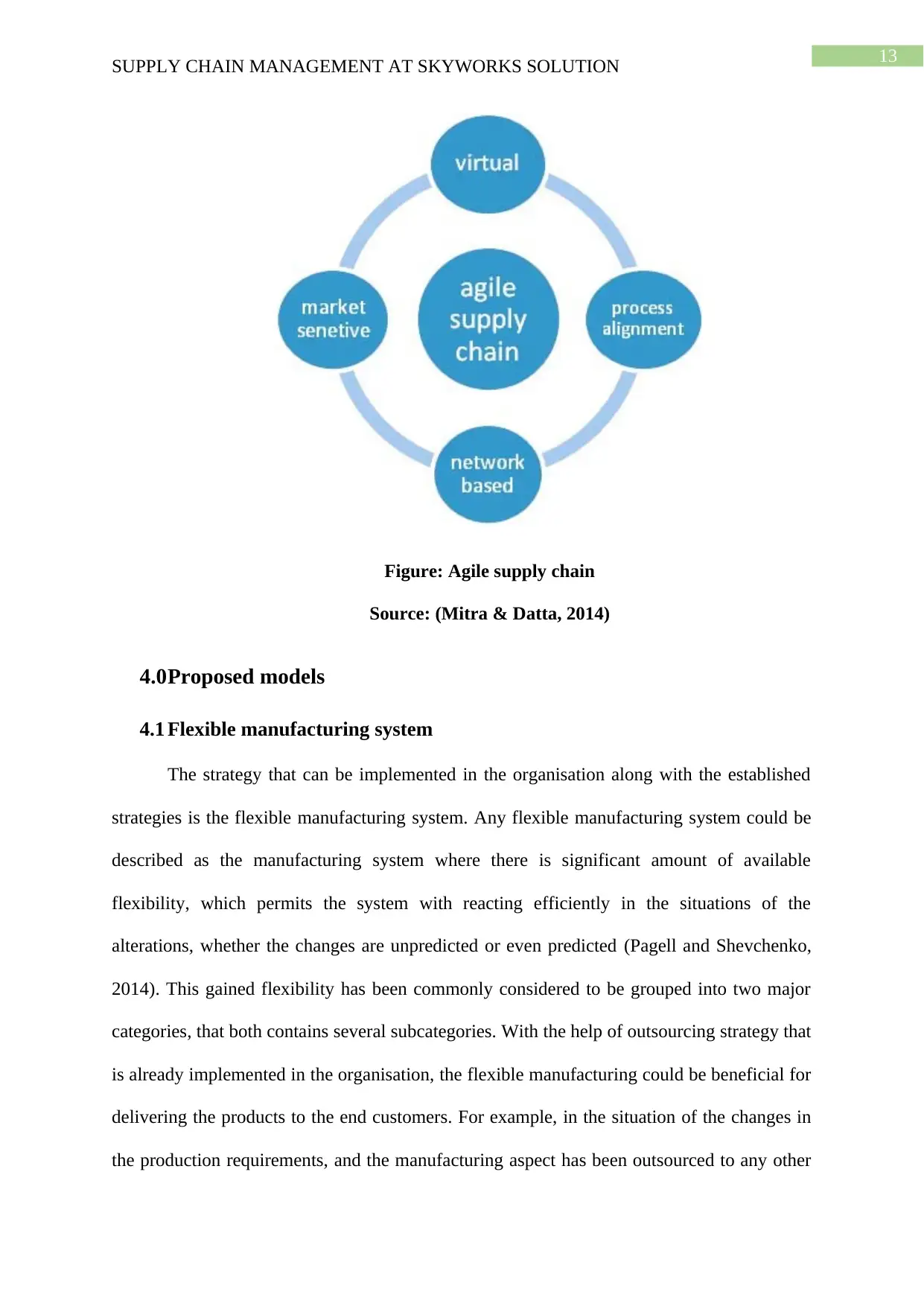
13
SUPPLY CHAIN MANAGEMENT AT SKYWORKS SOLUTION
Figure: Agile supply chain
Source: (Mitra & Datta, 2014)
4.0Proposed models
4.1 Flexible manufacturing system
The strategy that can be implemented in the organisation along with the established
strategies is the flexible manufacturing system. Any flexible manufacturing system could be
described as the manufacturing system where there is significant amount of available
flexibility, which permits the system with reacting efficiently in the situations of the
alterations, whether the changes are unpredicted or even predicted (Pagell and Shevchenko,
2014). This gained flexibility has been commonly considered to be grouped into two major
categories, that both contains several subcategories. With the help of outsourcing strategy that
is already implemented in the organisation, the flexible manufacturing could be beneficial for
delivering the products to the end customers. For example, in the situation of the changes in
the production requirements, and the manufacturing aspect has been outsourced to any other
SUPPLY CHAIN MANAGEMENT AT SKYWORKS SOLUTION
Figure: Agile supply chain
Source: (Mitra & Datta, 2014)
4.0Proposed models
4.1 Flexible manufacturing system
The strategy that can be implemented in the organisation along with the established
strategies is the flexible manufacturing system. Any flexible manufacturing system could be
described as the manufacturing system where there is significant amount of available
flexibility, which permits the system with reacting efficiently in the situations of the
alterations, whether the changes are unpredicted or even predicted (Pagell and Shevchenko,
2014). This gained flexibility has been commonly considered to be grouped into two major
categories, that both contains several subcategories. With the help of outsourcing strategy that
is already implemented in the organisation, the flexible manufacturing could be beneficial for
delivering the products to the end customers. For example, in the situation of the changes in
the production requirements, and the manufacturing aspect has been outsourced to any other
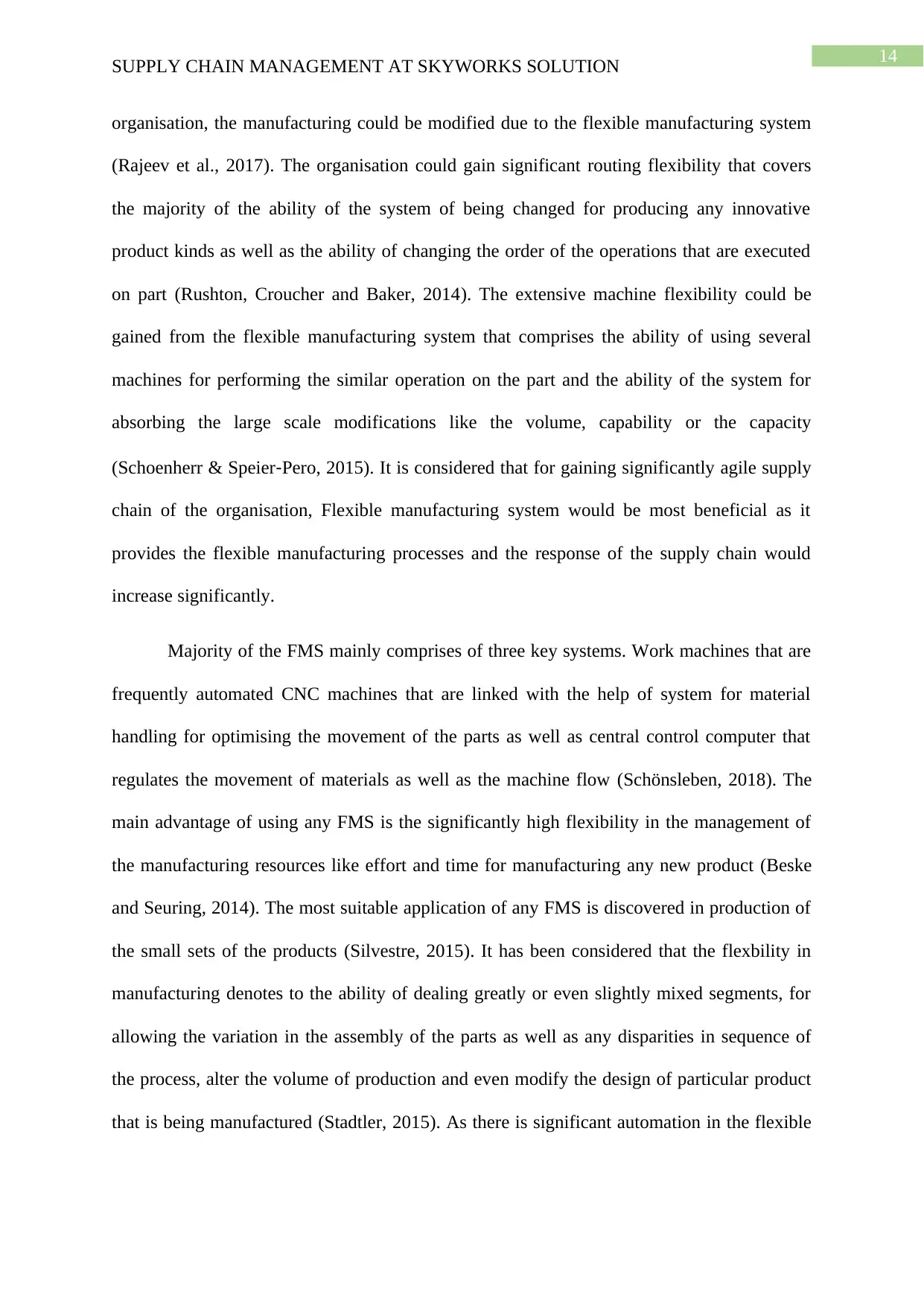
14
SUPPLY CHAIN MANAGEMENT AT SKYWORKS SOLUTION
organisation, the manufacturing could be modified due to the flexible manufacturing system
(Rajeev et al., 2017). The organisation could gain significant routing flexibility that covers
the majority of the ability of the system of being changed for producing any innovative
product kinds as well as the ability of changing the order of the operations that are executed
on part (Rushton, Croucher and Baker, 2014). The extensive machine flexibility could be
gained from the flexible manufacturing system that comprises the ability of using several
machines for performing the similar operation on the part and the ability of the system for
absorbing the large scale modifications like the volume, capability or the capacity
(Schoenherr & Speier‐Pero, 2015). It is considered that for gaining significantly agile supply
chain of the organisation, Flexible manufacturing system would be most beneficial as it
provides the flexible manufacturing processes and the response of the supply chain would
increase significantly.
Majority of the FMS mainly comprises of three key systems. Work machines that are
frequently automated CNC machines that are linked with the help of system for material
handling for optimising the movement of the parts as well as central control computer that
regulates the movement of materials as well as the machine flow (Schönsleben, 2018). The
main advantage of using any FMS is the significantly high flexibility in the management of
the manufacturing resources like effort and time for manufacturing any new product (Beske
and Seuring, 2014). The most suitable application of any FMS is discovered in production of
the small sets of the products (Silvestre, 2015). It has been considered that the flexbility in
manufacturing denotes to the ability of dealing greatly or even slightly mixed segments, for
allowing the variation in the assembly of the parts as well as any disparities in sequence of
the process, alter the volume of production and even modify the design of particular product
that is being manufactured (Stadtler, 2015). As there is significant automation in the flexible
SUPPLY CHAIN MANAGEMENT AT SKYWORKS SOLUTION
organisation, the manufacturing could be modified due to the flexible manufacturing system
(Rajeev et al., 2017). The organisation could gain significant routing flexibility that covers
the majority of the ability of the system of being changed for producing any innovative
product kinds as well as the ability of changing the order of the operations that are executed
on part (Rushton, Croucher and Baker, 2014). The extensive machine flexibility could be
gained from the flexible manufacturing system that comprises the ability of using several
machines for performing the similar operation on the part and the ability of the system for
absorbing the large scale modifications like the volume, capability or the capacity
(Schoenherr & Speier‐Pero, 2015). It is considered that for gaining significantly agile supply
chain of the organisation, Flexible manufacturing system would be most beneficial as it
provides the flexible manufacturing processes and the response of the supply chain would
increase significantly.
Majority of the FMS mainly comprises of three key systems. Work machines that are
frequently automated CNC machines that are linked with the help of system for material
handling for optimising the movement of the parts as well as central control computer that
regulates the movement of materials as well as the machine flow (Schönsleben, 2018). The
main advantage of using any FMS is the significantly high flexibility in the management of
the manufacturing resources like effort and time for manufacturing any new product (Beske
and Seuring, 2014). The most suitable application of any FMS is discovered in production of
the small sets of the products (Silvestre, 2015). It has been considered that the flexbility in
manufacturing denotes to the ability of dealing greatly or even slightly mixed segments, for
allowing the variation in the assembly of the parts as well as any disparities in sequence of
the process, alter the volume of production and even modify the design of particular product
that is being manufactured (Stadtler, 2015). As there is significant automation in the flexible
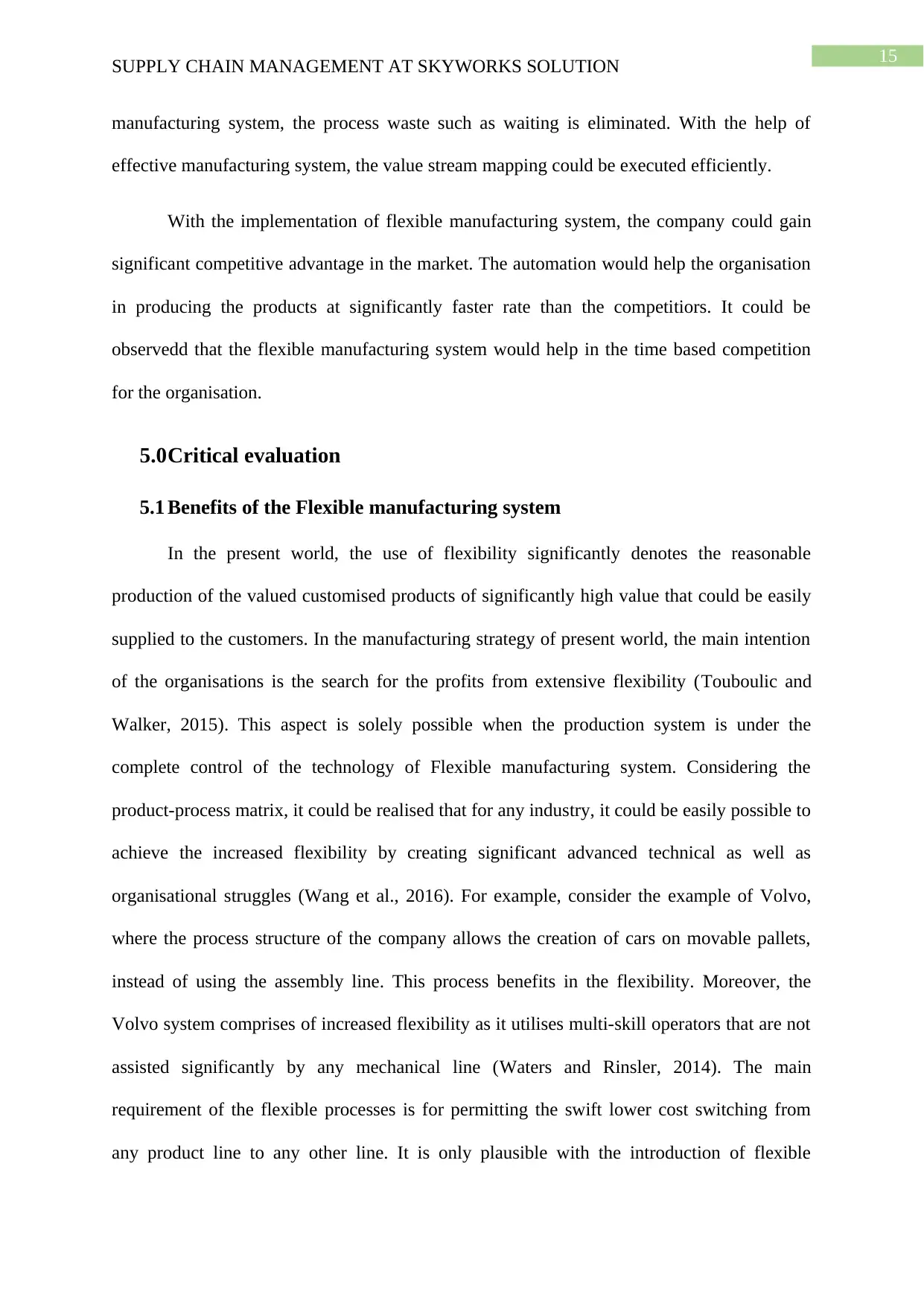
15
SUPPLY CHAIN MANAGEMENT AT SKYWORKS SOLUTION
manufacturing system, the process waste such as waiting is eliminated. With the help of
effective manufacturing system, the value stream mapping could be executed efficiently.
With the implementation of flexible manufacturing system, the company could gain
significant competitive advantage in the market. The automation would help the organisation
in producing the products at significantly faster rate than the competitiors. It could be
observedd that the flexible manufacturing system would help in the time based competition
for the organisation.
5.0Critical evaluation
5.1 Benefits of the Flexible manufacturing system
In the present world, the use of flexibility significantly denotes the reasonable
production of the valued customised products of significantly high value that could be easily
supplied to the customers. In the manufacturing strategy of present world, the main intention
of the organisations is the search for the profits from extensive flexibility (Touboulic and
Walker, 2015). This aspect is solely possible when the production system is under the
complete control of the technology of Flexible manufacturing system. Considering the
product-process matrix, it could be realised that for any industry, it could be easily possible to
achieve the increased flexibility by creating significant advanced technical as well as
organisational struggles (Wang et al., 2016). For example, consider the example of Volvo,
where the process structure of the company allows the creation of cars on movable pallets,
instead of using the assembly line. This process benefits in the flexibility. Moreover, the
Volvo system comprises of increased flexibility as it utilises multi-skill operators that are not
assisted significantly by any mechanical line (Waters and Rinsler, 2014). The main
requirement of the flexible processes is for permitting the swift lower cost switching from
any product line to any other line. It is only plausible with the introduction of flexible
SUPPLY CHAIN MANAGEMENT AT SKYWORKS SOLUTION
manufacturing system, the process waste such as waiting is eliminated. With the help of
effective manufacturing system, the value stream mapping could be executed efficiently.
With the implementation of flexible manufacturing system, the company could gain
significant competitive advantage in the market. The automation would help the organisation
in producing the products at significantly faster rate than the competitiors. It could be
observedd that the flexible manufacturing system would help in the time based competition
for the organisation.
5.0Critical evaluation
5.1 Benefits of the Flexible manufacturing system
In the present world, the use of flexibility significantly denotes the reasonable
production of the valued customised products of significantly high value that could be easily
supplied to the customers. In the manufacturing strategy of present world, the main intention
of the organisations is the search for the profits from extensive flexibility (Touboulic and
Walker, 2015). This aspect is solely possible when the production system is under the
complete control of the technology of Flexible manufacturing system. Considering the
product-process matrix, it could be realised that for any industry, it could be easily possible to
achieve the increased flexibility by creating significant advanced technical as well as
organisational struggles (Wang et al., 2016). For example, consider the example of Volvo,
where the process structure of the company allows the creation of cars on movable pallets,
instead of using the assembly line. This process benefits in the flexibility. Moreover, the
Volvo system comprises of increased flexibility as it utilises multi-skill operators that are not
assisted significantly by any mechanical line (Waters and Rinsler, 2014). The main
requirement of the flexible processes is for permitting the swift lower cost switching from
any product line to any other line. It is only plausible with the introduction of flexible
Secure Best Marks with AI Grader
Need help grading? Try our AI Grader for instant feedback on your assignments.
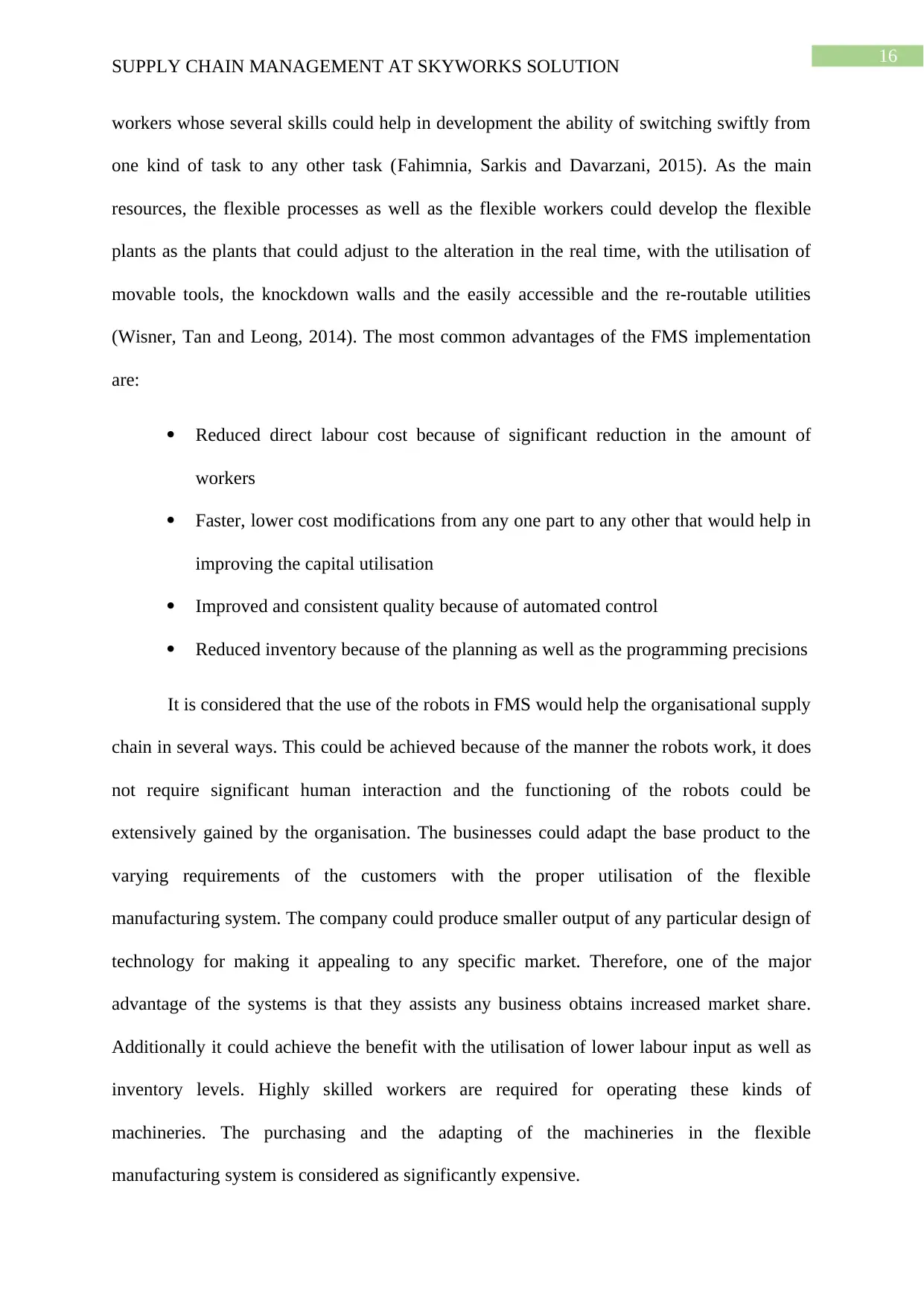
16
SUPPLY CHAIN MANAGEMENT AT SKYWORKS SOLUTION
workers whose several skills could help in development the ability of switching swiftly from
one kind of task to any other task (Fahimnia, Sarkis and Davarzani, 2015). As the main
resources, the flexible processes as well as the flexible workers could develop the flexible
plants as the plants that could adjust to the alteration in the real time, with the utilisation of
movable tools, the knockdown walls and the easily accessible and the re-routable utilities
(Wisner, Tan and Leong, 2014). The most common advantages of the FMS implementation
are:
Reduced direct labour cost because of significant reduction in the amount of
workers
Faster, lower cost modifications from any one part to any other that would help in
improving the capital utilisation
Improved and consistent quality because of automated control
Reduced inventory because of the planning as well as the programming precisions
It is considered that the use of the robots in FMS would help the organisational supply
chain in several ways. This could be achieved because of the manner the robots work, it does
not require significant human interaction and the functioning of the robots could be
extensively gained by the organisation. The businesses could adapt the base product to the
varying requirements of the customers with the proper utilisation of the flexible
manufacturing system. The company could produce smaller output of any particular design of
technology for making it appealing to any specific market. Therefore, one of the major
advantage of the systems is that they assists any business obtains increased market share.
Additionally it could achieve the benefit with the utilisation of lower labour input as well as
inventory levels. Highly skilled workers are required for operating these kinds of
machineries. The purchasing and the adapting of the machineries in the flexible
manufacturing system is considered as significantly expensive.
SUPPLY CHAIN MANAGEMENT AT SKYWORKS SOLUTION
workers whose several skills could help in development the ability of switching swiftly from
one kind of task to any other task (Fahimnia, Sarkis and Davarzani, 2015). As the main
resources, the flexible processes as well as the flexible workers could develop the flexible
plants as the plants that could adjust to the alteration in the real time, with the utilisation of
movable tools, the knockdown walls and the easily accessible and the re-routable utilities
(Wisner, Tan and Leong, 2014). The most common advantages of the FMS implementation
are:
Reduced direct labour cost because of significant reduction in the amount of
workers
Faster, lower cost modifications from any one part to any other that would help in
improving the capital utilisation
Improved and consistent quality because of automated control
Reduced inventory because of the planning as well as the programming precisions
It is considered that the use of the robots in FMS would help the organisational supply
chain in several ways. This could be achieved because of the manner the robots work, it does
not require significant human interaction and the functioning of the robots could be
extensively gained by the organisation. The businesses could adapt the base product to the
varying requirements of the customers with the proper utilisation of the flexible
manufacturing system. The company could produce smaller output of any particular design of
technology for making it appealing to any specific market. Therefore, one of the major
advantage of the systems is that they assists any business obtains increased market share.
Additionally it could achieve the benefit with the utilisation of lower labour input as well as
inventory levels. Highly skilled workers are required for operating these kinds of
machineries. The purchasing and the adapting of the machineries in the flexible
manufacturing system is considered as significantly expensive.
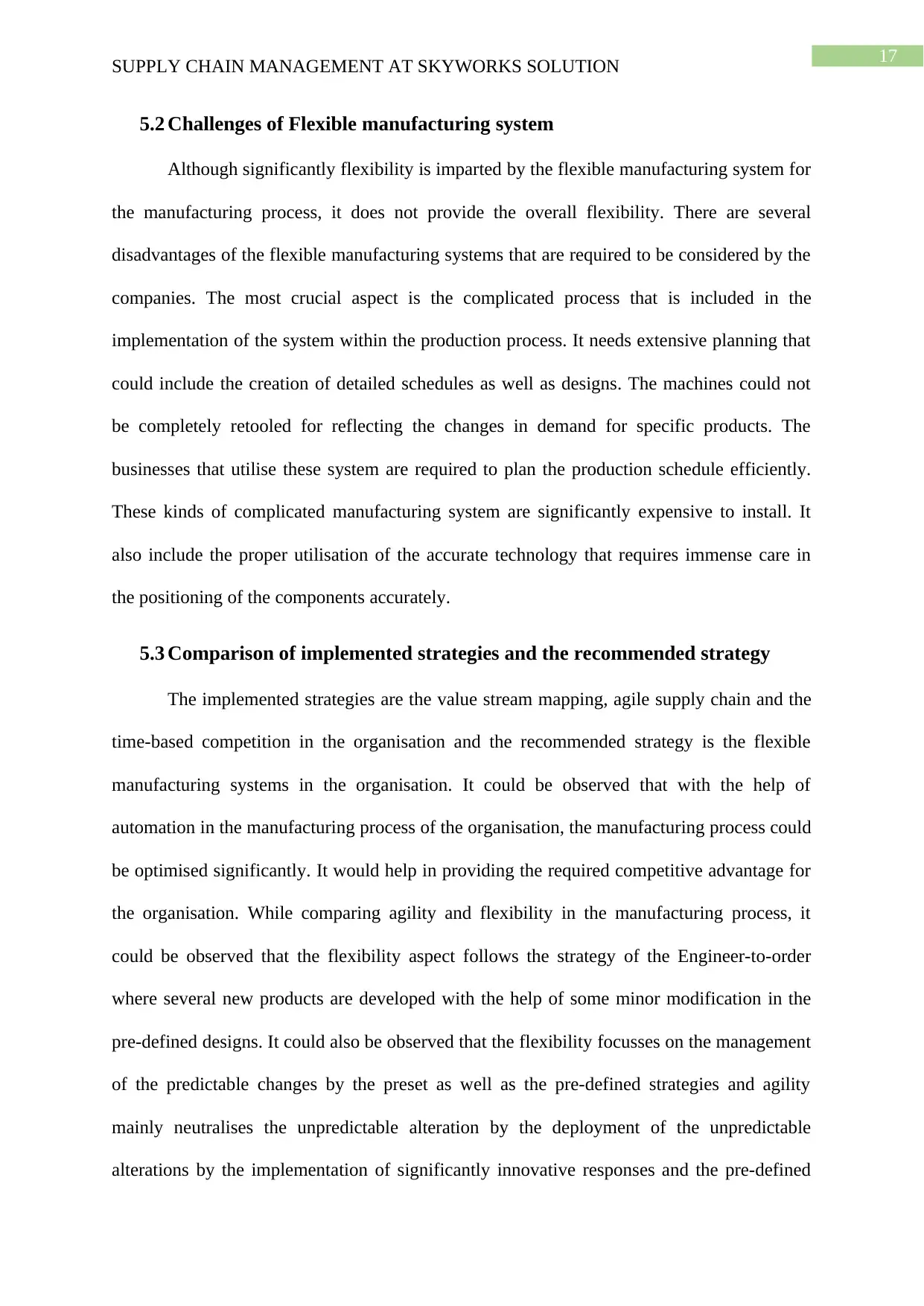
17
SUPPLY CHAIN MANAGEMENT AT SKYWORKS SOLUTION
5.2 Challenges of Flexible manufacturing system
Although significantly flexibility is imparted by the flexible manufacturing system for
the manufacturing process, it does not provide the overall flexibility. There are several
disadvantages of the flexible manufacturing systems that are required to be considered by the
companies. The most crucial aspect is the complicated process that is included in the
implementation of the system within the production process. It needs extensive planning that
could include the creation of detailed schedules as well as designs. The machines could not
be completely retooled for reflecting the changes in demand for specific products. The
businesses that utilise these system are required to plan the production schedule efficiently.
These kinds of complicated manufacturing system are significantly expensive to install. It
also include the proper utilisation of the accurate technology that requires immense care in
the positioning of the components accurately.
5.3 Comparison of implemented strategies and the recommended strategy
The implemented strategies are the value stream mapping, agile supply chain and the
time-based competition in the organisation and the recommended strategy is the flexible
manufacturing systems in the organisation. It could be observed that with the help of
automation in the manufacturing process of the organisation, the manufacturing process could
be optimised significantly. It would help in providing the required competitive advantage for
the organisation. While comparing agility and flexibility in the manufacturing process, it
could be observed that the flexibility aspect follows the strategy of the Engineer-to-order
where several new products are developed with the help of some minor modification in the
pre-defined designs. It could also be observed that the flexibility focusses on the management
of the predictable changes by the preset as well as the pre-defined strategies and agility
mainly neutralises the unpredictable alteration by the deployment of the unpredictable
alterations by the implementation of significantly innovative responses and the pre-defined
SUPPLY CHAIN MANAGEMENT AT SKYWORKS SOLUTION
5.2 Challenges of Flexible manufacturing system
Although significantly flexibility is imparted by the flexible manufacturing system for
the manufacturing process, it does not provide the overall flexibility. There are several
disadvantages of the flexible manufacturing systems that are required to be considered by the
companies. The most crucial aspect is the complicated process that is included in the
implementation of the system within the production process. It needs extensive planning that
could include the creation of detailed schedules as well as designs. The machines could not
be completely retooled for reflecting the changes in demand for specific products. The
businesses that utilise these system are required to plan the production schedule efficiently.
These kinds of complicated manufacturing system are significantly expensive to install. It
also include the proper utilisation of the accurate technology that requires immense care in
the positioning of the components accurately.
5.3 Comparison of implemented strategies and the recommended strategy
The implemented strategies are the value stream mapping, agile supply chain and the
time-based competition in the organisation and the recommended strategy is the flexible
manufacturing systems in the organisation. It could be observed that with the help of
automation in the manufacturing process of the organisation, the manufacturing process could
be optimised significantly. It would help in providing the required competitive advantage for
the organisation. While comparing agility and flexibility in the manufacturing process, it
could be observed that the flexibility aspect follows the strategy of the Engineer-to-order
where several new products are developed with the help of some minor modification in the
pre-defined designs. It could also be observed that the flexibility focusses on the management
of the predictable changes by the preset as well as the pre-defined strategies and agility
mainly neutralises the unpredictable alteration by the deployment of the unpredictable
alterations by the implementation of significantly innovative responses and the pre-defined
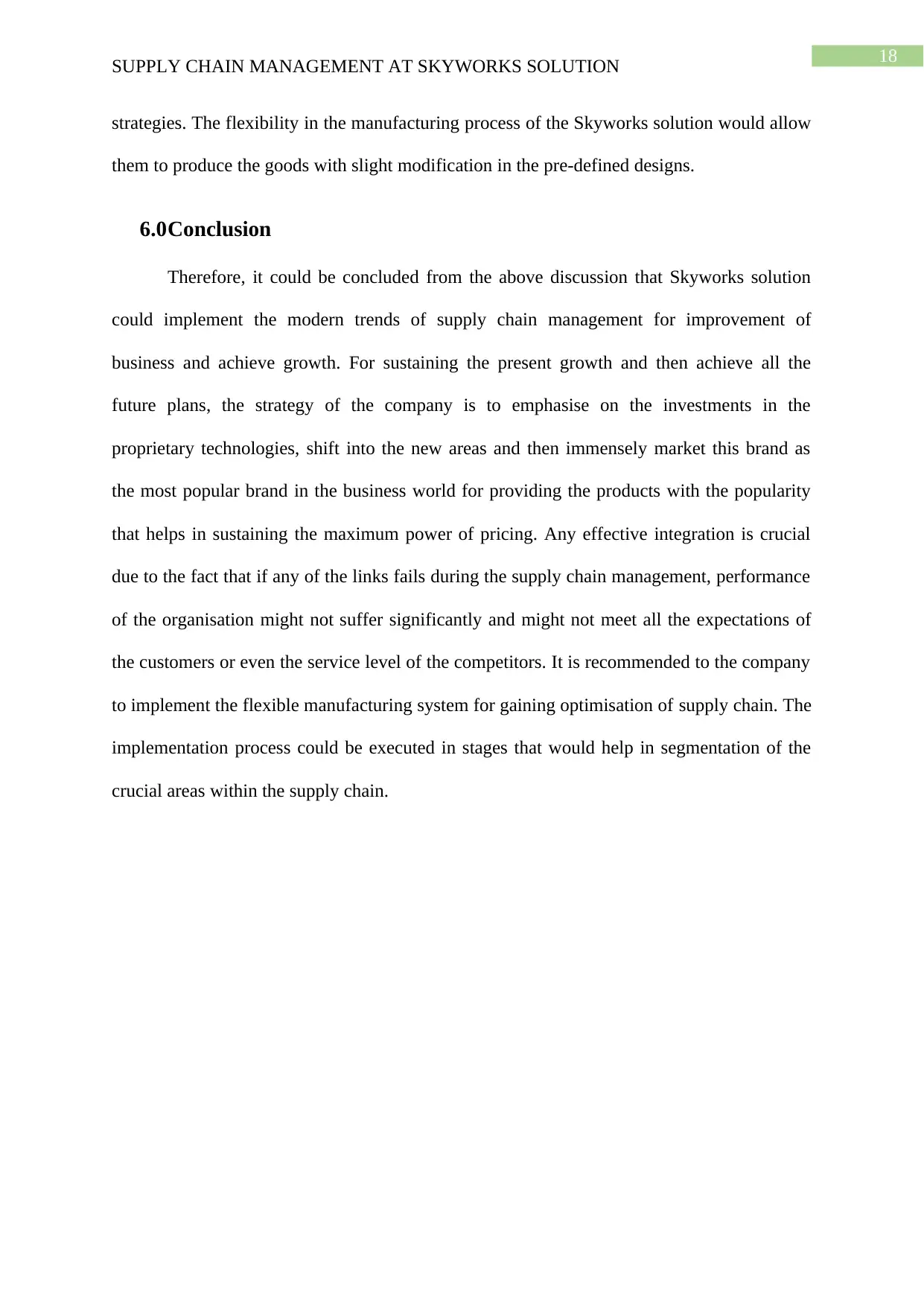
18
SUPPLY CHAIN MANAGEMENT AT SKYWORKS SOLUTION
strategies. The flexibility in the manufacturing process of the Skyworks solution would allow
them to produce the goods with slight modification in the pre-defined designs.
6.0Conclusion
Therefore, it could be concluded from the above discussion that Skyworks solution
could implement the modern trends of supply chain management for improvement of
business and achieve growth. For sustaining the present growth and then achieve all the
future plans, the strategy of the company is to emphasise on the investments in the
proprietary technologies, shift into the new areas and then immensely market this brand as
the most popular brand in the business world for providing the products with the popularity
that helps in sustaining the maximum power of pricing. Any effective integration is crucial
due to the fact that if any of the links fails during the supply chain management, performance
of the organisation might not suffer significantly and might not meet all the expectations of
the customers or even the service level of the competitors. It is recommended to the company
to implement the flexible manufacturing system for gaining optimisation of supply chain. The
implementation process could be executed in stages that would help in segmentation of the
crucial areas within the supply chain.
SUPPLY CHAIN MANAGEMENT AT SKYWORKS SOLUTION
strategies. The flexibility in the manufacturing process of the Skyworks solution would allow
them to produce the goods with slight modification in the pre-defined designs.
6.0Conclusion
Therefore, it could be concluded from the above discussion that Skyworks solution
could implement the modern trends of supply chain management for improvement of
business and achieve growth. For sustaining the present growth and then achieve all the
future plans, the strategy of the company is to emphasise on the investments in the
proprietary technologies, shift into the new areas and then immensely market this brand as
the most popular brand in the business world for providing the products with the popularity
that helps in sustaining the maximum power of pricing. Any effective integration is crucial
due to the fact that if any of the links fails during the supply chain management, performance
of the organisation might not suffer significantly and might not meet all the expectations of
the customers or even the service level of the competitors. It is recommended to the company
to implement the flexible manufacturing system for gaining optimisation of supply chain. The
implementation process could be executed in stages that would help in segmentation of the
crucial areas within the supply chain.
Paraphrase This Document
Need a fresh take? Get an instant paraphrase of this document with our AI Paraphraser
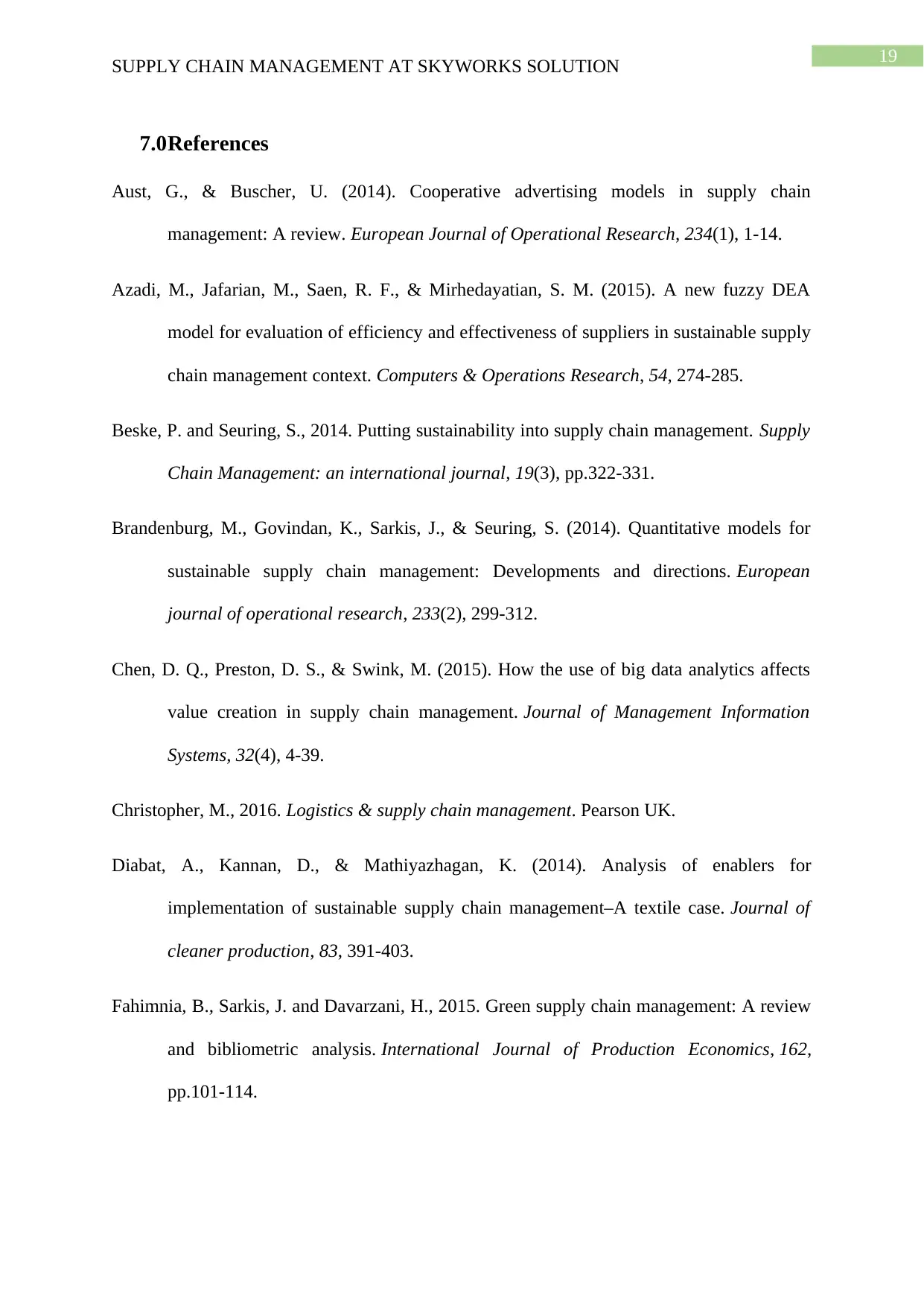
19
SUPPLY CHAIN MANAGEMENT AT SKYWORKS SOLUTION
7.0References
Aust, G., & Buscher, U. (2014). Cooperative advertising models in supply chain
management: A review. European Journal of Operational Research, 234(1), 1-14.
Azadi, M., Jafarian, M., Saen, R. F., & Mirhedayatian, S. M. (2015). A new fuzzy DEA
model for evaluation of efficiency and effectiveness of suppliers in sustainable supply
chain management context. Computers & Operations Research, 54, 274-285.
Beske, P. and Seuring, S., 2014. Putting sustainability into supply chain management. Supply
Chain Management: an international journal, 19(3), pp.322-331.
Brandenburg, M., Govindan, K., Sarkis, J., & Seuring, S. (2014). Quantitative models for
sustainable supply chain management: Developments and directions. European
journal of operational research, 233(2), 299-312.
Chen, D. Q., Preston, D. S., & Swink, M. (2015). How the use of big data analytics affects
value creation in supply chain management. Journal of Management Information
Systems, 32(4), 4-39.
Christopher, M., 2016. Logistics & supply chain management. Pearson UK.
Diabat, A., Kannan, D., & Mathiyazhagan, K. (2014). Analysis of enablers for
implementation of sustainable supply chain management–A textile case. Journal of
cleaner production, 83, 391-403.
Fahimnia, B., Sarkis, J. and Davarzani, H., 2015. Green supply chain management: A review
and bibliometric analysis. International Journal of Production Economics, 162,
pp.101-114.
SUPPLY CHAIN MANAGEMENT AT SKYWORKS SOLUTION
7.0References
Aust, G., & Buscher, U. (2014). Cooperative advertising models in supply chain
management: A review. European Journal of Operational Research, 234(1), 1-14.
Azadi, M., Jafarian, M., Saen, R. F., & Mirhedayatian, S. M. (2015). A new fuzzy DEA
model for evaluation of efficiency and effectiveness of suppliers in sustainable supply
chain management context. Computers & Operations Research, 54, 274-285.
Beske, P. and Seuring, S., 2014. Putting sustainability into supply chain management. Supply
Chain Management: an international journal, 19(3), pp.322-331.
Brandenburg, M., Govindan, K., Sarkis, J., & Seuring, S. (2014). Quantitative models for
sustainable supply chain management: Developments and directions. European
journal of operational research, 233(2), 299-312.
Chen, D. Q., Preston, D. S., & Swink, M. (2015). How the use of big data analytics affects
value creation in supply chain management. Journal of Management Information
Systems, 32(4), 4-39.
Christopher, M., 2016. Logistics & supply chain management. Pearson UK.
Diabat, A., Kannan, D., & Mathiyazhagan, K. (2014). Analysis of enablers for
implementation of sustainable supply chain management–A textile case. Journal of
cleaner production, 83, 391-403.
Fahimnia, B., Sarkis, J. and Davarzani, H., 2015. Green supply chain management: A review
and bibliometric analysis. International Journal of Production Economics, 162,
pp.101-114.
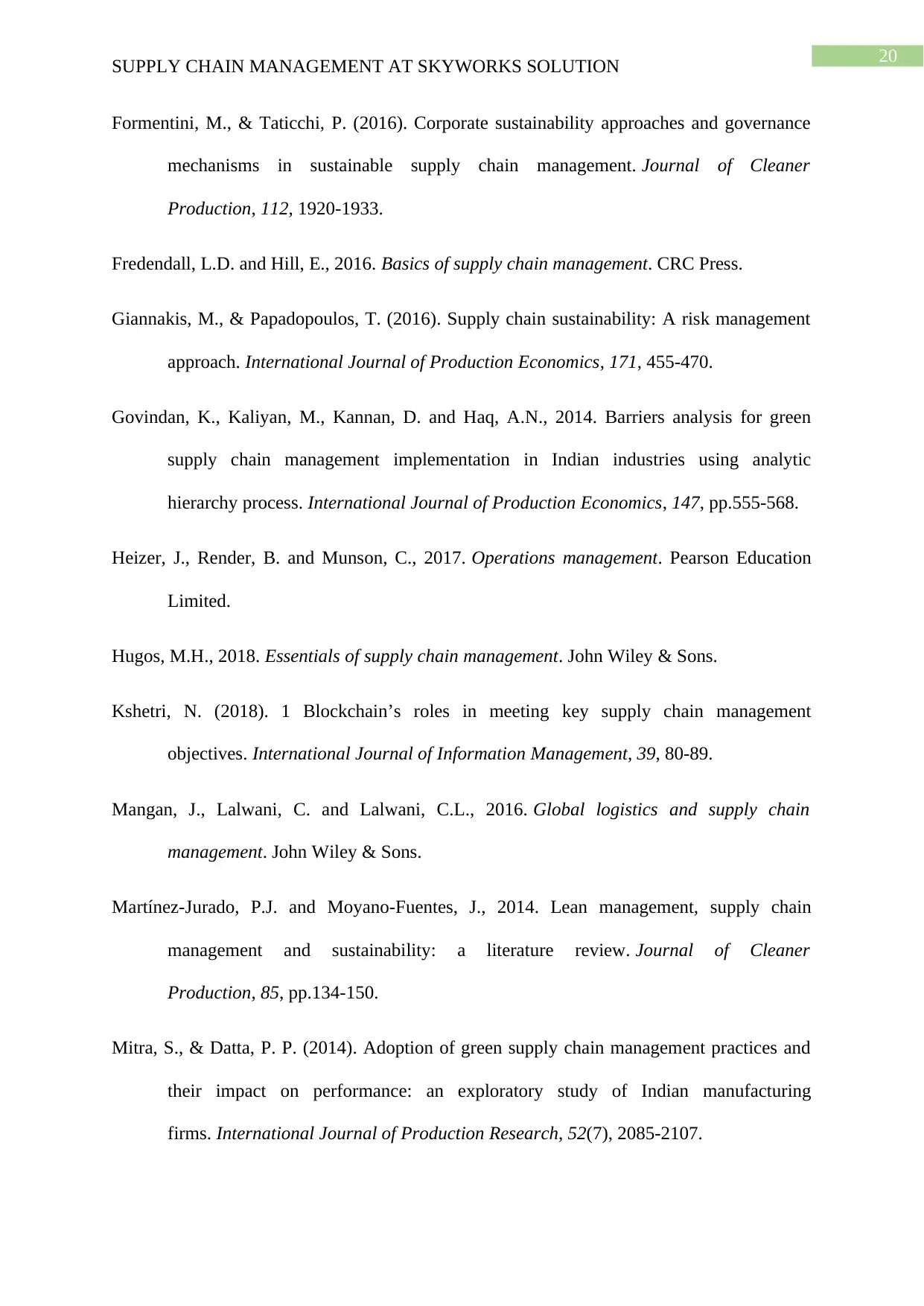
20
SUPPLY CHAIN MANAGEMENT AT SKYWORKS SOLUTION
Formentini, M., & Taticchi, P. (2016). Corporate sustainability approaches and governance
mechanisms in sustainable supply chain management. Journal of Cleaner
Production, 112, 1920-1933.
Fredendall, L.D. and Hill, E., 2016. Basics of supply chain management. CRC Press.
Giannakis, M., & Papadopoulos, T. (2016). Supply chain sustainability: A risk management
approach. International Journal of Production Economics, 171, 455-470.
Govindan, K., Kaliyan, M., Kannan, D. and Haq, A.N., 2014. Barriers analysis for green
supply chain management implementation in Indian industries using analytic
hierarchy process. International Journal of Production Economics, 147, pp.555-568.
Heizer, J., Render, B. and Munson, C., 2017. Operations management. Pearson Education
Limited.
Hugos, M.H., 2018. Essentials of supply chain management. John Wiley & Sons.
Kshetri, N. (2018). 1 Blockchain’s roles in meeting key supply chain management
objectives. International Journal of Information Management, 39, 80-89.
Mangan, J., Lalwani, C. and Lalwani, C.L., 2016. Global logistics and supply chain
management. John Wiley & Sons.
Martínez-Jurado, P.J. and Moyano-Fuentes, J., 2014. Lean management, supply chain
management and sustainability: a literature review. Journal of Cleaner
Production, 85, pp.134-150.
Mitra, S., & Datta, P. P. (2014). Adoption of green supply chain management practices and
their impact on performance: an exploratory study of Indian manufacturing
firms. International Journal of Production Research, 52(7), 2085-2107.
SUPPLY CHAIN MANAGEMENT AT SKYWORKS SOLUTION
Formentini, M., & Taticchi, P. (2016). Corporate sustainability approaches and governance
mechanisms in sustainable supply chain management. Journal of Cleaner
Production, 112, 1920-1933.
Fredendall, L.D. and Hill, E., 2016. Basics of supply chain management. CRC Press.
Giannakis, M., & Papadopoulos, T. (2016). Supply chain sustainability: A risk management
approach. International Journal of Production Economics, 171, 455-470.
Govindan, K., Kaliyan, M., Kannan, D. and Haq, A.N., 2014. Barriers analysis for green
supply chain management implementation in Indian industries using analytic
hierarchy process. International Journal of Production Economics, 147, pp.555-568.
Heizer, J., Render, B. and Munson, C., 2017. Operations management. Pearson Education
Limited.
Hugos, M.H., 2018. Essentials of supply chain management. John Wiley & Sons.
Kshetri, N. (2018). 1 Blockchain’s roles in meeting key supply chain management
objectives. International Journal of Information Management, 39, 80-89.
Mangan, J., Lalwani, C. and Lalwani, C.L., 2016. Global logistics and supply chain
management. John Wiley & Sons.
Martínez-Jurado, P.J. and Moyano-Fuentes, J., 2014. Lean management, supply chain
management and sustainability: a literature review. Journal of Cleaner
Production, 85, pp.134-150.
Mitra, S., & Datta, P. P. (2014). Adoption of green supply chain management practices and
their impact on performance: an exploratory study of Indian manufacturing
firms. International Journal of Production Research, 52(7), 2085-2107.
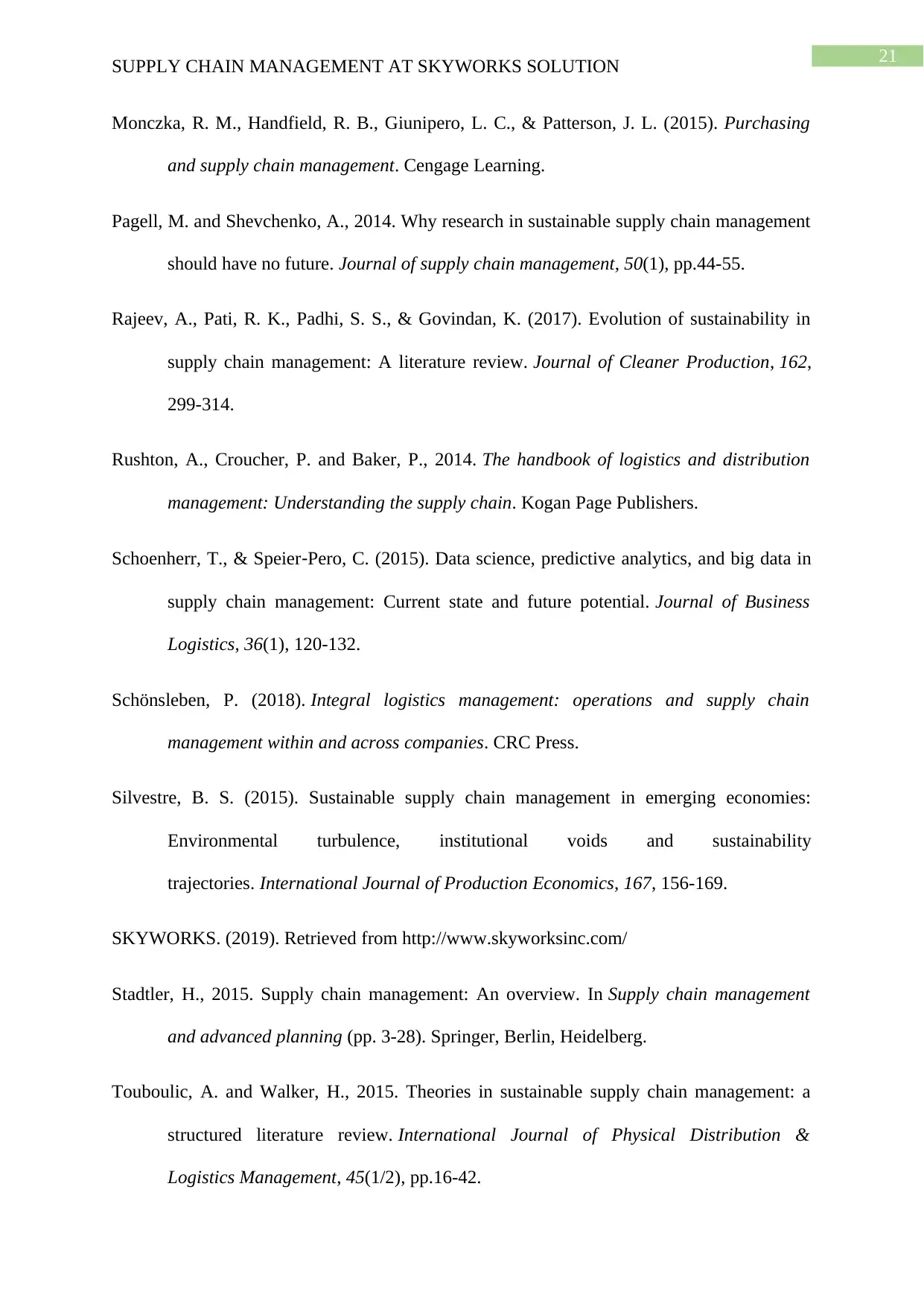
21
SUPPLY CHAIN MANAGEMENT AT SKYWORKS SOLUTION
Monczka, R. M., Handfield, R. B., Giunipero, L. C., & Patterson, J. L. (2015). Purchasing
and supply chain management. Cengage Learning.
Pagell, M. and Shevchenko, A., 2014. Why research in sustainable supply chain management
should have no future. Journal of supply chain management, 50(1), pp.44-55.
Rajeev, A., Pati, R. K., Padhi, S. S., & Govindan, K. (2017). Evolution of sustainability in
supply chain management: A literature review. Journal of Cleaner Production, 162,
299-314.
Rushton, A., Croucher, P. and Baker, P., 2014. The handbook of logistics and distribution
management: Understanding the supply chain. Kogan Page Publishers.
Schoenherr, T., & Speier‐Pero, C. (2015). Data science, predictive analytics, and big data in
supply chain management: Current state and future potential. Journal of Business
Logistics, 36(1), 120-132.
Schönsleben, P. (2018). Integral logistics management: operations and supply chain
management within and across companies. CRC Press.
Silvestre, B. S. (2015). Sustainable supply chain management in emerging economies:
Environmental turbulence, institutional voids and sustainability
trajectories. International Journal of Production Economics, 167, 156-169.
SKYWORKS. (2019). Retrieved from http://www.skyworksinc.com/
Stadtler, H., 2015. Supply chain management: An overview. In Supply chain management
and advanced planning (pp. 3-28). Springer, Berlin, Heidelberg.
Touboulic, A. and Walker, H., 2015. Theories in sustainable supply chain management: a
structured literature review. International Journal of Physical Distribution &
Logistics Management, 45(1/2), pp.16-42.
SUPPLY CHAIN MANAGEMENT AT SKYWORKS SOLUTION
Monczka, R. M., Handfield, R. B., Giunipero, L. C., & Patterson, J. L. (2015). Purchasing
and supply chain management. Cengage Learning.
Pagell, M. and Shevchenko, A., 2014. Why research in sustainable supply chain management
should have no future. Journal of supply chain management, 50(1), pp.44-55.
Rajeev, A., Pati, R. K., Padhi, S. S., & Govindan, K. (2017). Evolution of sustainability in
supply chain management: A literature review. Journal of Cleaner Production, 162,
299-314.
Rushton, A., Croucher, P. and Baker, P., 2014. The handbook of logistics and distribution
management: Understanding the supply chain. Kogan Page Publishers.
Schoenherr, T., & Speier‐Pero, C. (2015). Data science, predictive analytics, and big data in
supply chain management: Current state and future potential. Journal of Business
Logistics, 36(1), 120-132.
Schönsleben, P. (2018). Integral logistics management: operations and supply chain
management within and across companies. CRC Press.
Silvestre, B. S. (2015). Sustainable supply chain management in emerging economies:
Environmental turbulence, institutional voids and sustainability
trajectories. International Journal of Production Economics, 167, 156-169.
SKYWORKS. (2019). Retrieved from http://www.skyworksinc.com/
Stadtler, H., 2015. Supply chain management: An overview. In Supply chain management
and advanced planning (pp. 3-28). Springer, Berlin, Heidelberg.
Touboulic, A. and Walker, H., 2015. Theories in sustainable supply chain management: a
structured literature review. International Journal of Physical Distribution &
Logistics Management, 45(1/2), pp.16-42.
Secure Best Marks with AI Grader
Need help grading? Try our AI Grader for instant feedback on your assignments.
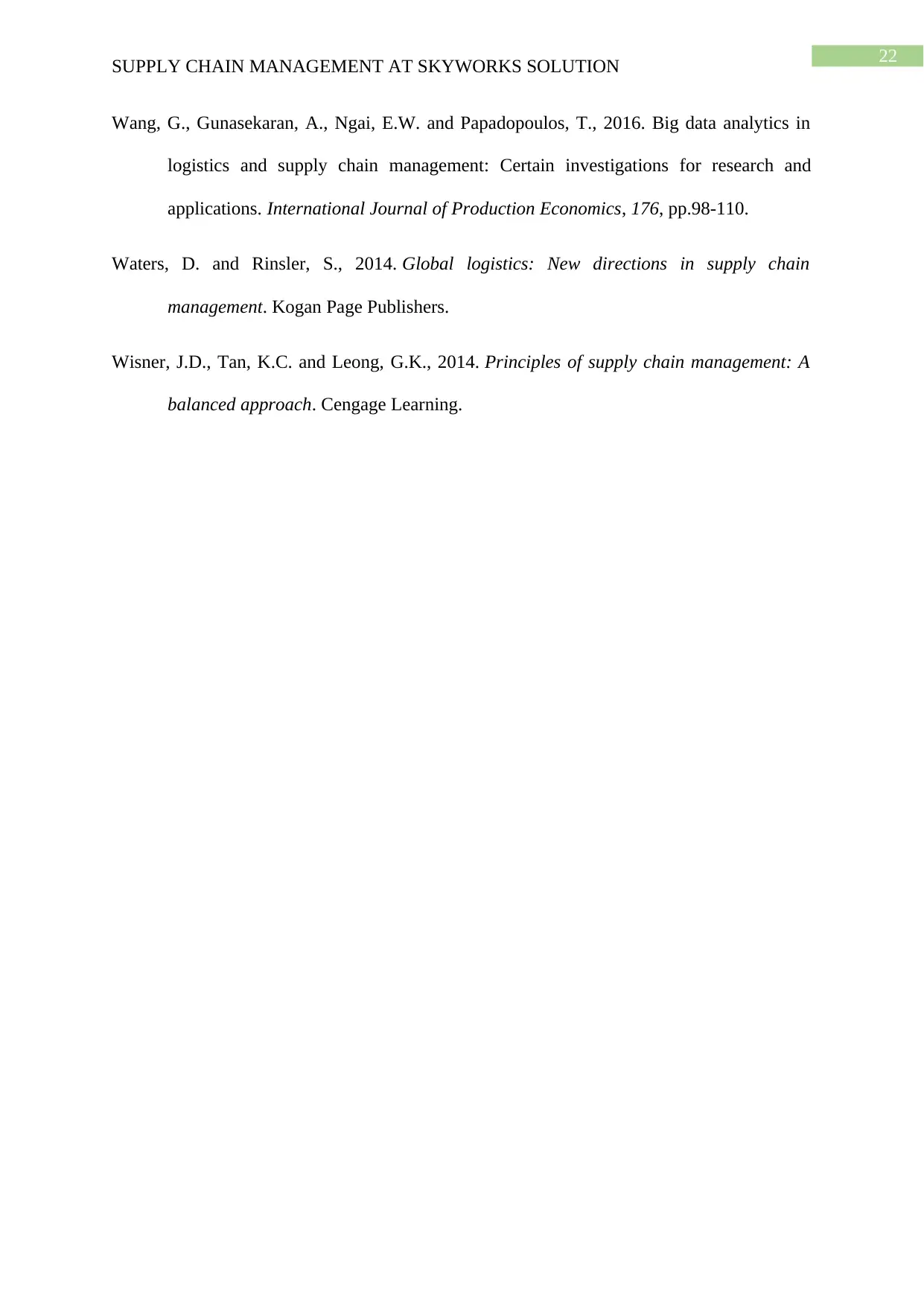
22
SUPPLY CHAIN MANAGEMENT AT SKYWORKS SOLUTION
Wang, G., Gunasekaran, A., Ngai, E.W. and Papadopoulos, T., 2016. Big data analytics in
logistics and supply chain management: Certain investigations for research and
applications. International Journal of Production Economics, 176, pp.98-110.
Waters, D. and Rinsler, S., 2014. Global logistics: New directions in supply chain
management. Kogan Page Publishers.
Wisner, J.D., Tan, K.C. and Leong, G.K., 2014. Principles of supply chain management: A
balanced approach. Cengage Learning.
SUPPLY CHAIN MANAGEMENT AT SKYWORKS SOLUTION
Wang, G., Gunasekaran, A., Ngai, E.W. and Papadopoulos, T., 2016. Big data analytics in
logistics and supply chain management: Certain investigations for research and
applications. International Journal of Production Economics, 176, pp.98-110.
Waters, D. and Rinsler, S., 2014. Global logistics: New directions in supply chain
management. Kogan Page Publishers.
Wisner, J.D., Tan, K.C. and Leong, G.K., 2014. Principles of supply chain management: A
balanced approach. Cengage Learning.
1 out of 23
Related Documents
Your All-in-One AI-Powered Toolkit for Academic Success.
+13062052269
info@desklib.com
Available 24*7 on WhatsApp / Email
![[object Object]](/_next/static/media/star-bottom.7253800d.svg)
Unlock your academic potential
© 2024 | Zucol Services PVT LTD | All rights reserved.




